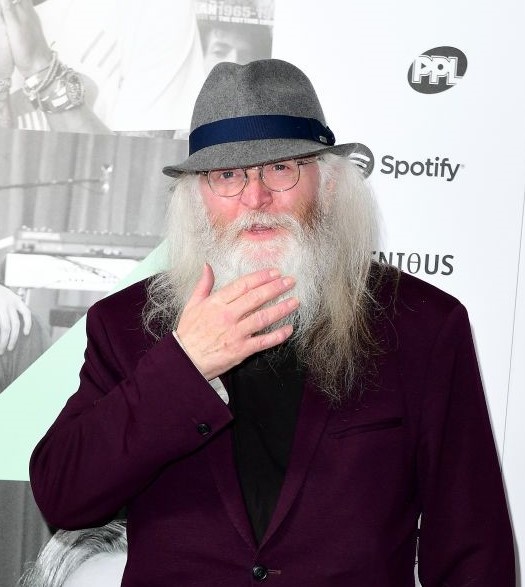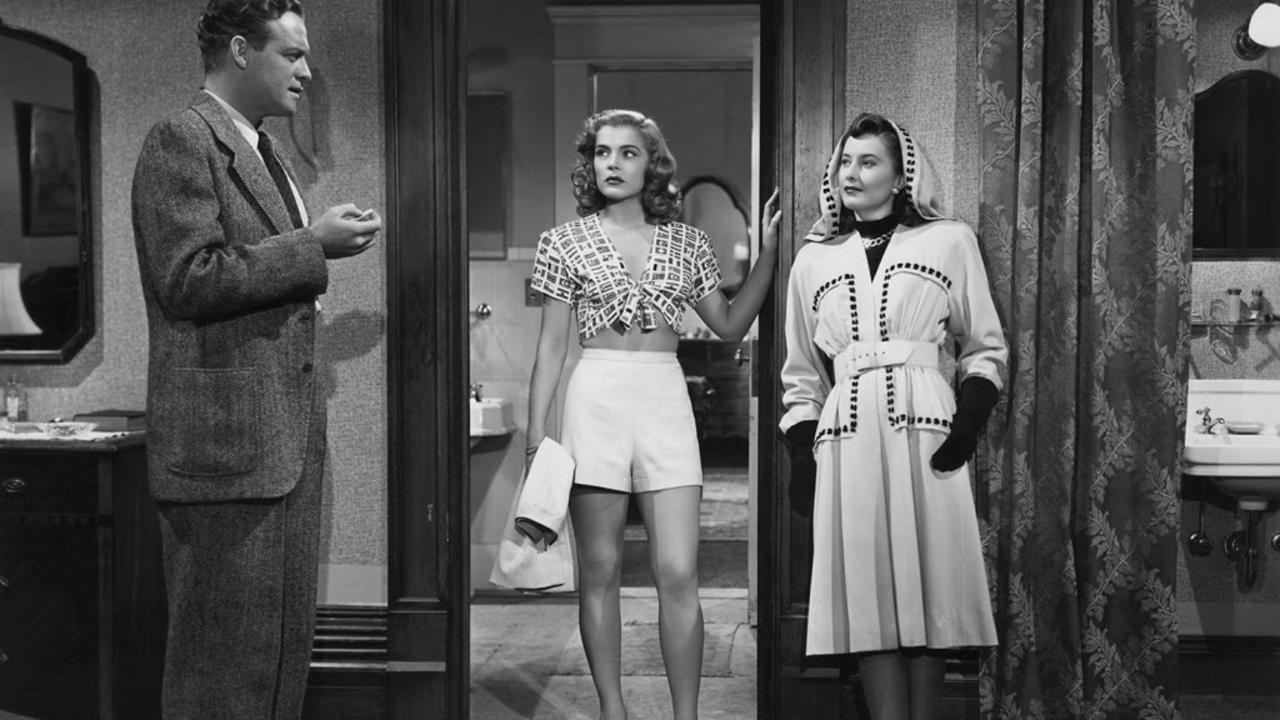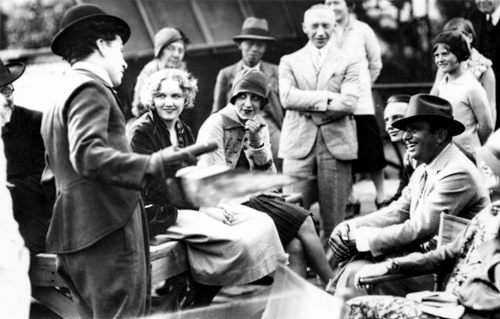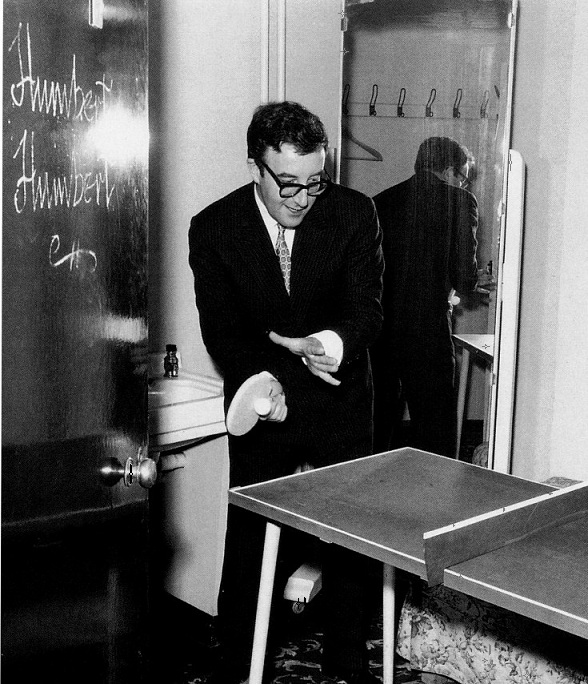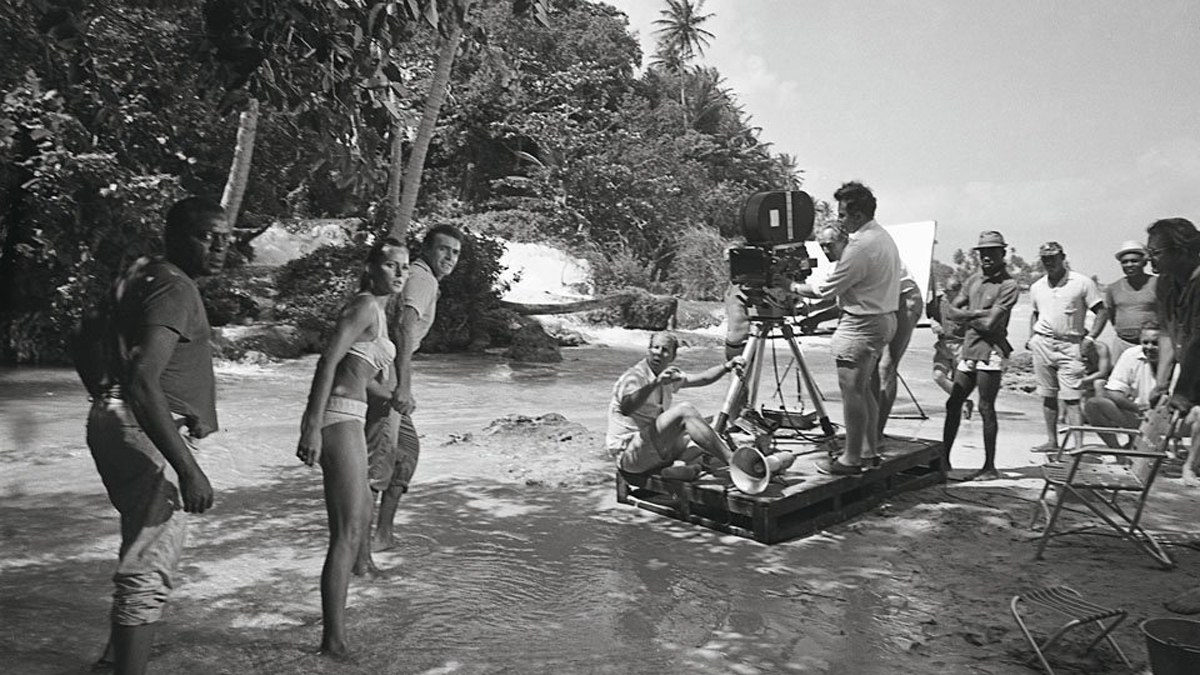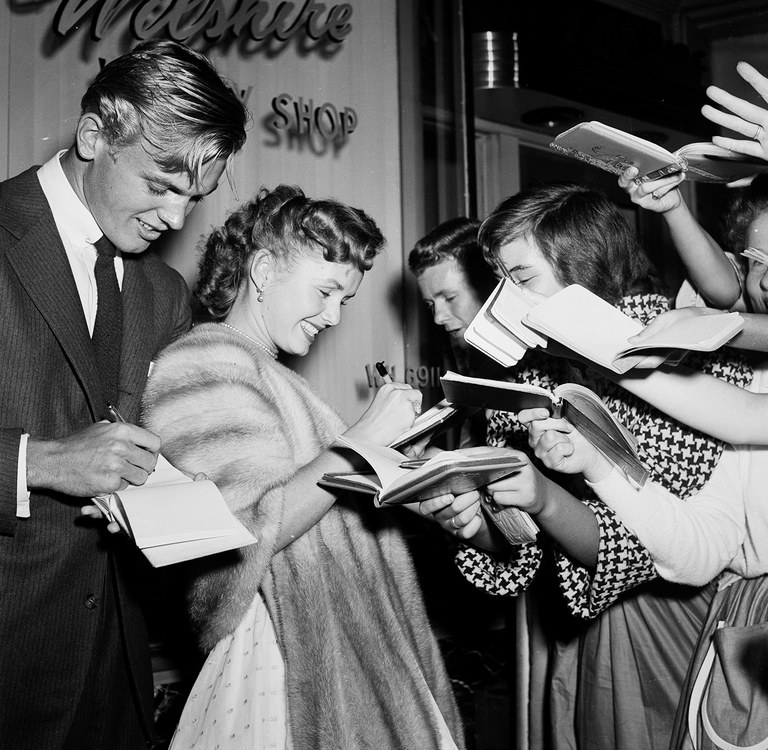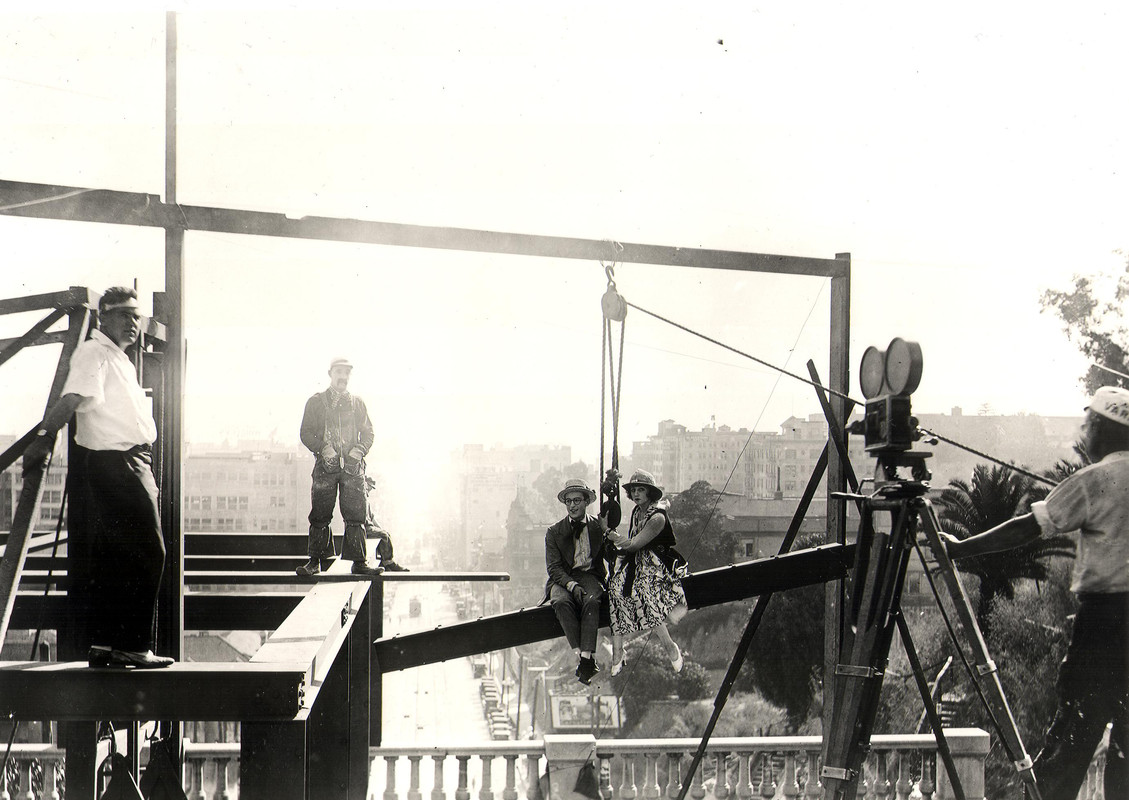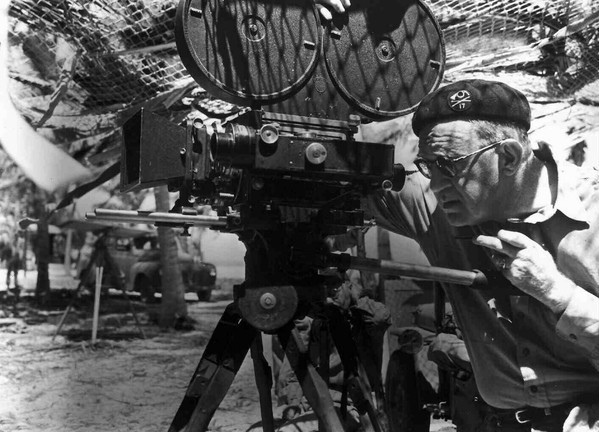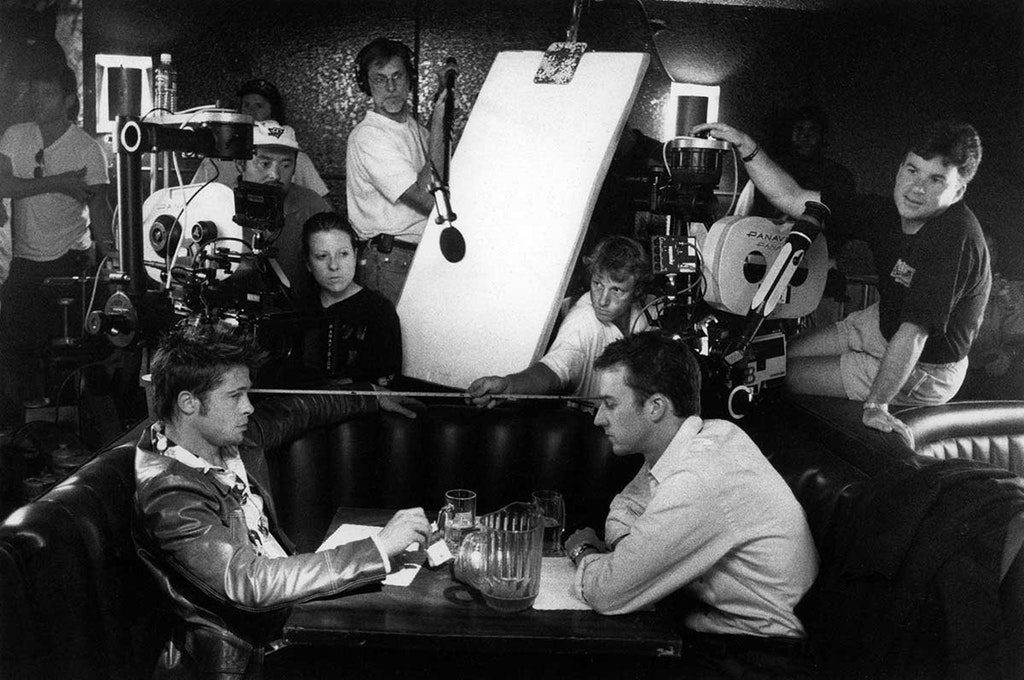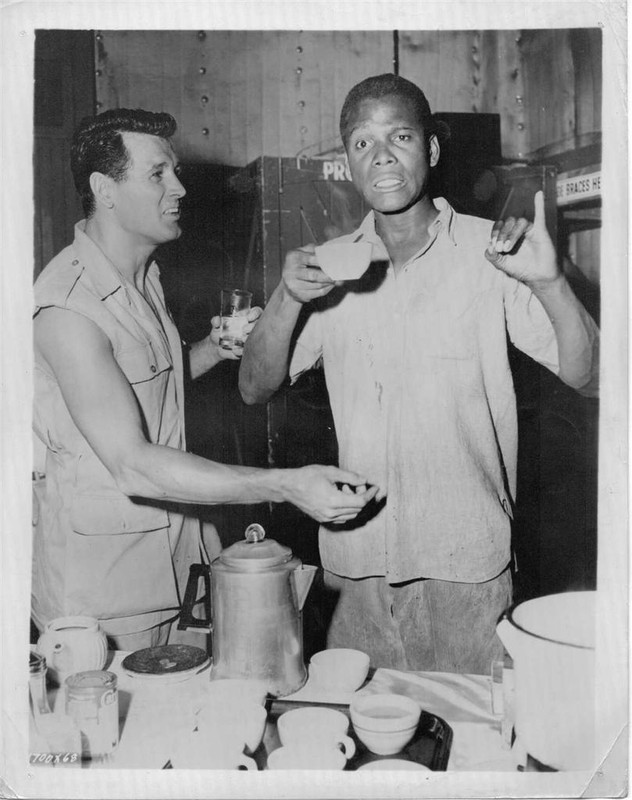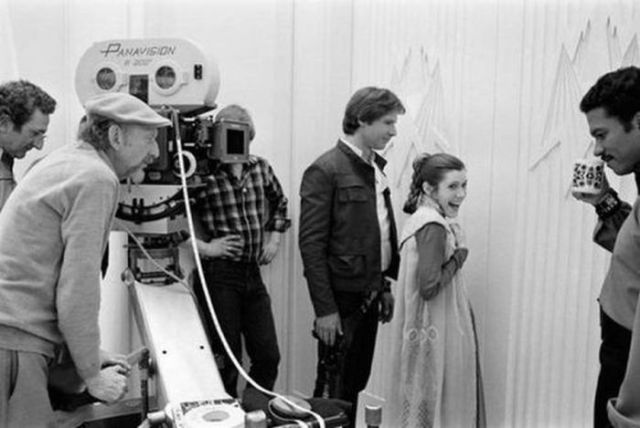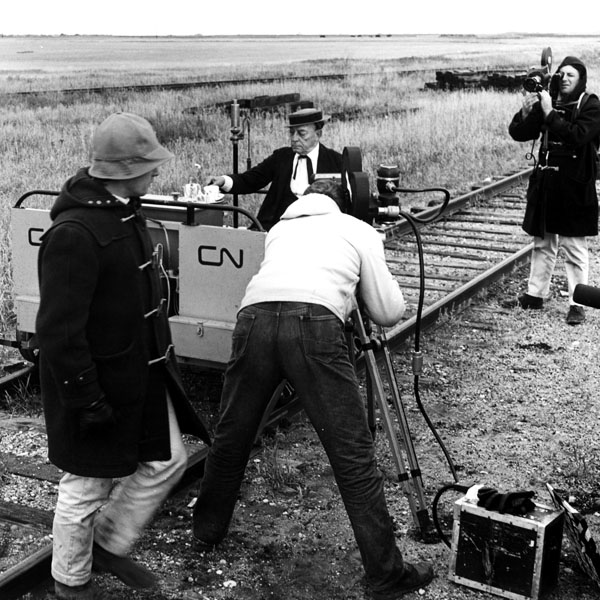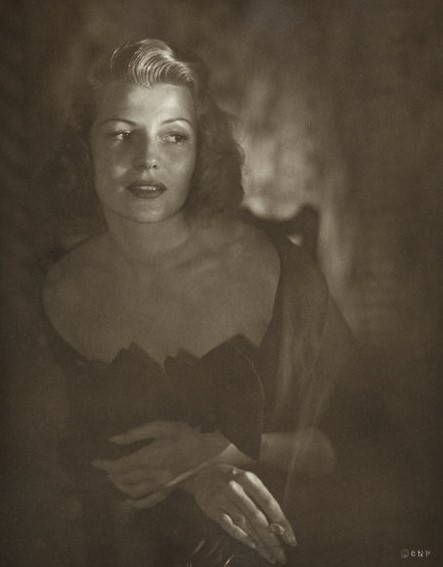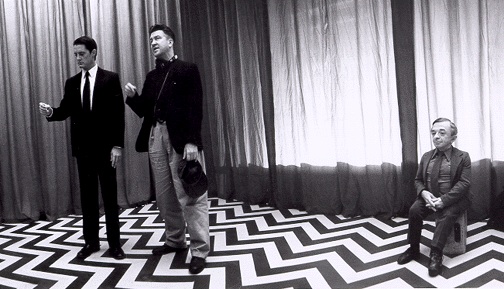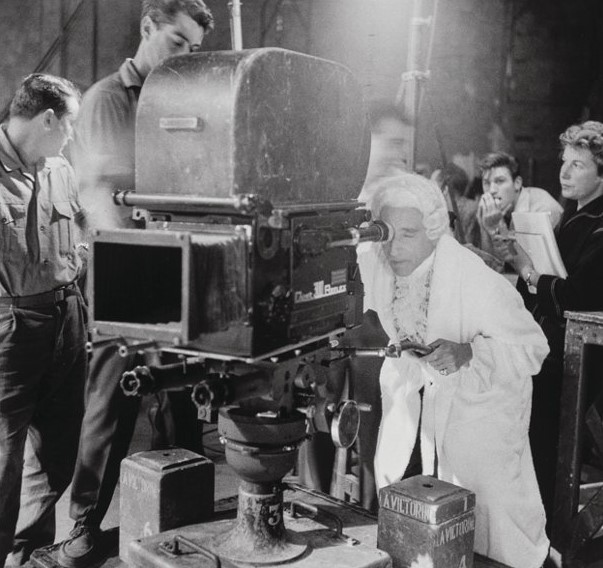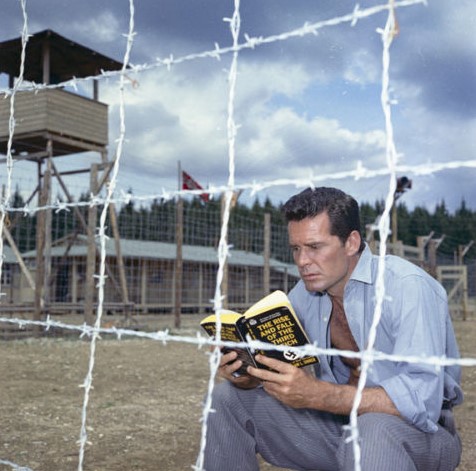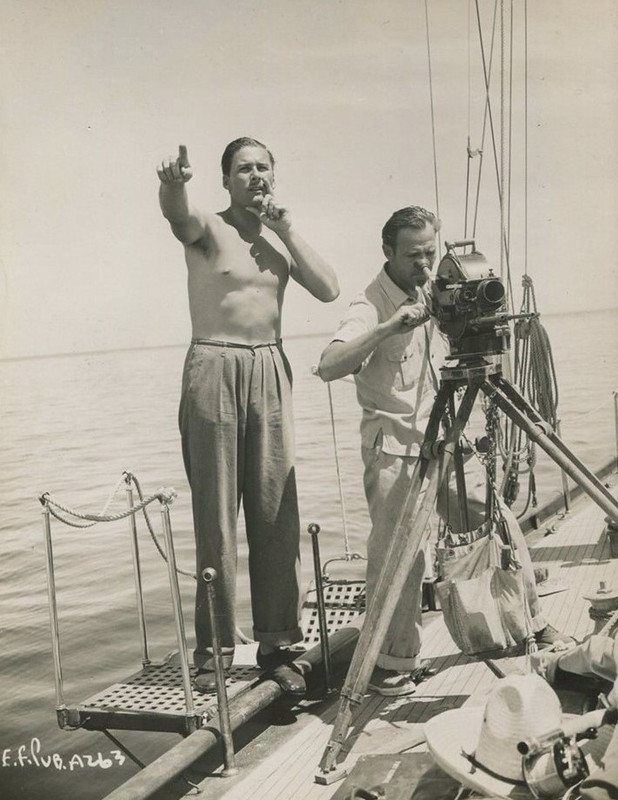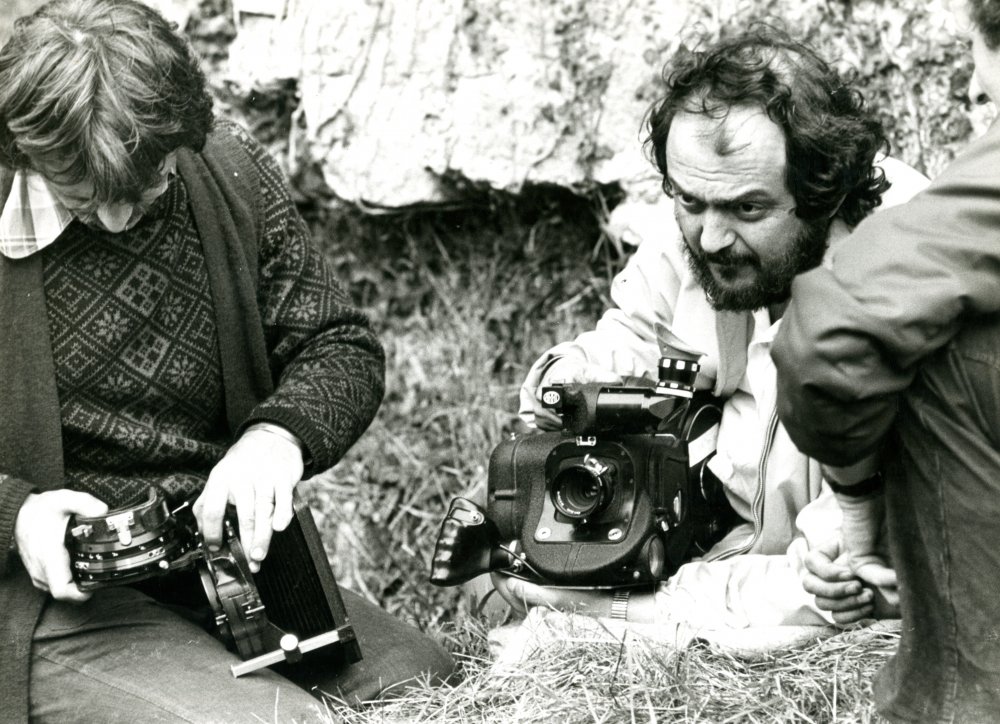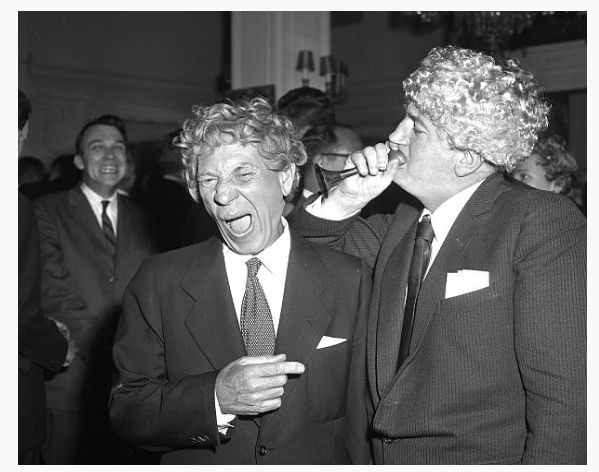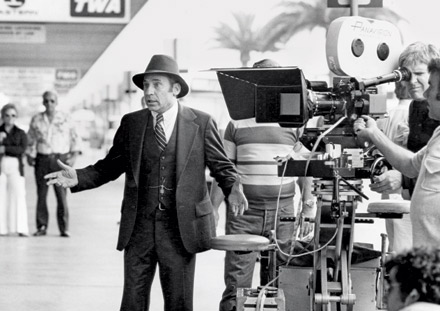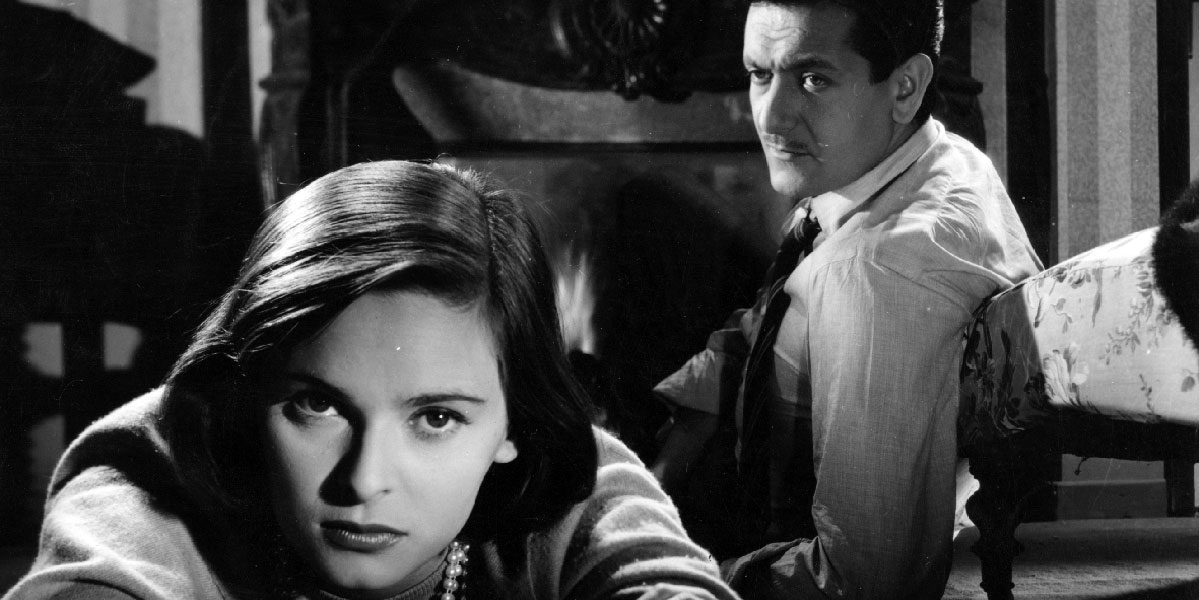Monday, 31 December 2018
Sunday, 30 December 2018
June Whitfield RIP

Comic actor whose career ranged from Take It from Here on the radio to Terry and June and Absolutely Fabulous on TV
Stephen Dixon
The Guardian
Sat 29 Dec 2018
June Whitfield, who has died aged 93, was the most extraordinarily ordinary of comic performers. Efficient, amenable and ultra-professional, she unselfishly supported star comedians for seven decades, often slyly outshining them. Yet buried deep in the screen image of sensible housewife or mum there was a wonderfully wild streak.
On radio, she was Eth to Dick Bentley’s Ron in radio’s Take It from Here in the 1950s; partnered Roy Hudd in The News Huddlines on Radio 2 (1984-2000); and was Agatha Christie’s Miss Marple for Radio 4 (1993-2001). She partnered Arthur Askey on television for six years and played Terry Scott’s wife in Happy Ever After, then in Terry and June, for an astonishing 13 years. And she captivated a new generation as Jennifer Saunders’s vague but sometimes acerbic mother in Absolutely Fabulous.
The success of her partnership with Scott – she had worked with him before Happy Ever After in the TV series Scott On… – gives a clue to her enduring comic appeal. At the time – 1974 to 1987 – Terry and June was derided by critics and the younger, more abrasive comedians as the epitome of cosy, middle-class BBC sitcom, but from today’s perspective it looks positively surreal. Scott, who previously toured a “naughty schoolboy” act in variety for years, essentially played a wilful child, and Whitfield seemed more like a patient mother than a wife. However, in most episodes there was a point at which she surrendered herself and wholeheartedly joined in whatever anarchic plan Scott had hatched, usually to save him from disaster. When this happened, the pair became quietly deranged, and the comic dynamic far from the conventional whimsy sniffed at by the critics.
At various times over the years Whitfield played wife or girlfriend to Benny Hill, Frankie Howerd, Dick Emery, Tony Hancock, Jimmy Edwards, Sid James, Ted Ray, Leslie Phillips, Stanley Baxter, Bob Monkhouse, Harry H Corbett, Tommy Cooper, Terry Thomas, Leslie Crowther and Ronnie Barker. The writer Barry Took said that she had supported more actors than the Department of Health and Social Security.
Sat 29 Dec 2018
June Whitfield, who has died aged 93, was the most extraordinarily ordinary of comic performers. Efficient, amenable and ultra-professional, she unselfishly supported star comedians for seven decades, often slyly outshining them. Yet buried deep in the screen image of sensible housewife or mum there was a wonderfully wild streak.
On radio, she was Eth to Dick Bentley’s Ron in radio’s Take It from Here in the 1950s; partnered Roy Hudd in The News Huddlines on Radio 2 (1984-2000); and was Agatha Christie’s Miss Marple for Radio 4 (1993-2001). She partnered Arthur Askey on television for six years and played Terry Scott’s wife in Happy Ever After, then in Terry and June, for an astonishing 13 years. And she captivated a new generation as Jennifer Saunders’s vague but sometimes acerbic mother in Absolutely Fabulous.
The success of her partnership with Scott – she had worked with him before Happy Ever After in the TV series Scott On… – gives a clue to her enduring comic appeal. At the time – 1974 to 1987 – Terry and June was derided by critics and the younger, more abrasive comedians as the epitome of cosy, middle-class BBC sitcom, but from today’s perspective it looks positively surreal. Scott, who previously toured a “naughty schoolboy” act in variety for years, essentially played a wilful child, and Whitfield seemed more like a patient mother than a wife. However, in most episodes there was a point at which she surrendered herself and wholeheartedly joined in whatever anarchic plan Scott had hatched, usually to save him from disaster. When this happened, the pair became quietly deranged, and the comic dynamic far from the conventional whimsy sniffed at by the critics.
At various times over the years Whitfield played wife or girlfriend to Benny Hill, Frankie Howerd, Dick Emery, Tony Hancock, Jimmy Edwards, Sid James, Ted Ray, Leslie Phillips, Stanley Baxter, Bob Monkhouse, Harry H Corbett, Tommy Cooper, Terry Thomas, Leslie Crowther and Ronnie Barker. The writer Barry Took said that she had supported more actors than the Department of Health and Social Security.
June Whitfield was born in Streatham, south London. Her father, Jack, was managing director of Dictograph Internal Telephones and her mother, Bertha, an incurably stagestruck woman who channelled her energies into amateur theatre and then into her daughter’s career. At the age of three June attended the Robinson School of Dancing, Elocution, Pianoforte and Singing, and when she was 12, her performance as Moth in an amateur production of Love’s Labours Lost elicited a favourable review in The Star newspaper. In 1942 she enrolled at the Royal Academy of Dramatic Art, and after leaving in 1944, she was almost never out of work for the rest of her life.
Whitfield always claimed that lack of confidence in her looks made her decide to concentrate on comedy: “I believed that, since the audience was going to laugh at me anyway, I might as well be in things that were meant to be laughed at.”
In the mid-1940s she toured Britain in several plays, and in 1945 worked with the Yorkshire comic actor and radio quizmaster Wilfred Pickles. Pickles taught her about timing; on her first night on tour in the comedy The Cure For Love there was a scene where she sat on his knee, gabbling her lines as Pickles hissed at her out of the corner of his mouth: “Wait for the laugh. Wait for the laugh.”
In 1950 she caught the eye of Noel Coward, who cast her in his unsuccessful revue Ace of Clubs. She asked Coward if she could wear a fringe in the show, and her doubts about her appearance were hardly allayed when he replied: “Good idea. It’ll hide that vast expanse of forehead.”
Whitfield understudied Mary Martin in South Pacific at Drury Lane in 1951 and went on to a bigger part in Daddy Long Legs at the Saville. While she was appearing in Love For Judy in 1953, she received a call from Frank Muir and Denis Norden, writers of the hit radio show Take It From Here, inviting her to audition for the part vacated by Joy Nichols. She got the job, and joined the cast just as Muir and Norden were trying out a new series of sketches involving the unpleasant and indolent Glum Family. For Eth, Ron Glum’s earnest and worried fiancee, Whitfield “borrowed” the whining voice of her mother’s daily help, who never suspected that she was being immortalised on radio. Whitfield’s breathy anxiety perfectly complemented Dick Bentley’s flat, Australian monotone in exchanges such as:
Eth: “Ooh, Ron, It’s not natural for hot-blooded people like you and me to remain unmarried indefinitely. Oh, dear heart, if only you knew how much I yearn!”
Ron: “I do, Eth, and it’s not enough for both of us to live on.”
The show made Whitfield a household name. When she married surveyor Tim Aitchison in 1955 one newspaper headline read “Ooh, Ron! Look what’s happened to Eth!” The marriage, regarded as one of the happiest in British showbusiness, endured until Aitchison’s death in 2001. Their daughter, Suzy, is also an actor.
She became a regular on Arthur Askey’s Before Your Very Eyes in 1956, then played his wife in the Arthur Askey Show in 1961. She also appeared in the Tony Hancock Show, the comic’s first series for ITV, and when he moved back to the BBC in 1961 she went with him.
Whitfield always claimed that lack of confidence in her looks made her decide to concentrate on comedy: “I believed that, since the audience was going to laugh at me anyway, I might as well be in things that were meant to be laughed at.”
In the mid-1940s she toured Britain in several plays, and in 1945 worked with the Yorkshire comic actor and radio quizmaster Wilfred Pickles. Pickles taught her about timing; on her first night on tour in the comedy The Cure For Love there was a scene where she sat on his knee, gabbling her lines as Pickles hissed at her out of the corner of his mouth: “Wait for the laugh. Wait for the laugh.”
In 1950 she caught the eye of Noel Coward, who cast her in his unsuccessful revue Ace of Clubs. She asked Coward if she could wear a fringe in the show, and her doubts about her appearance were hardly allayed when he replied: “Good idea. It’ll hide that vast expanse of forehead.”
Whitfield understudied Mary Martin in South Pacific at Drury Lane in 1951 and went on to a bigger part in Daddy Long Legs at the Saville. While she was appearing in Love For Judy in 1953, she received a call from Frank Muir and Denis Norden, writers of the hit radio show Take It From Here, inviting her to audition for the part vacated by Joy Nichols. She got the job, and joined the cast just as Muir and Norden were trying out a new series of sketches involving the unpleasant and indolent Glum Family. For Eth, Ron Glum’s earnest and worried fiancee, Whitfield “borrowed” the whining voice of her mother’s daily help, who never suspected that she was being immortalised on radio. Whitfield’s breathy anxiety perfectly complemented Dick Bentley’s flat, Australian monotone in exchanges such as:
Eth: “Ooh, Ron, It’s not natural for hot-blooded people like you and me to remain unmarried indefinitely. Oh, dear heart, if only you knew how much I yearn!”
Ron: “I do, Eth, and it’s not enough for both of us to live on.”
The show made Whitfield a household name. When she married surveyor Tim Aitchison in 1955 one newspaper headline read “Ooh, Ron! Look what’s happened to Eth!” The marriage, regarded as one of the happiest in British showbusiness, endured until Aitchison’s death in 2001. Their daughter, Suzy, is also an actor.
She became a regular on Arthur Askey’s Before Your Very Eyes in 1956, then played his wife in the Arthur Askey Show in 1961. She also appeared in the Tony Hancock Show, the comic’s first series for ITV, and when he moved back to the BBC in 1961 she went with him.
Whitfield was a regular fixture in comedy films and television shows through the 1960s, and first appeared with Terry Scott in 1968. After the success of Scott on… it was suggested that they team up in a situation comedy, and Happy Ever After, written by John Chapman and Eric Merriman, was introduced in 1974. It was an immediate success, but after five series Chapman thought the formula was exhausted and quit; the BBC wanted to persevere, however, and because of a dispute over rights, the names of the characters changed and the title became Terry and June, mostly written by John Kane. Over both series, Scott and Whitfield notched up a staggering 107 episodes, and became so identified as a couple that some viewers thought they were married in real life.
Offscreen, however, the discreet and fastidious Whitfield and the opinionated Scott had little in common. On the set she was content to acknowledge that her main function was to “drift the laughter towards Terry’s lines”.
Because of Whitfield’s cosy image, the idea of casting her as Jennifer Saunders’s mother in Absolutely Fabulous in 1992 was a comedy masterstroke. Whitfield and Julia Sawalha (as granddaughter, Saffron) provided the calm centre of this blisteringly funny series about two vodka-swilling, drug-addled friends – Saunders as PR agent Edina Monsoon and Joanna Lumley as magazine editor Patsy. Mother, slightly senile and preoccupied with her puzzle books, and Saffy represented traditional virtues of consideration and respect for others. The show ran for five series, plus specials and a 2016 film, and is ranked as 17th in the greatest British TV shows of all time by the British Film Institute. In recent years Whitfield appeared in episodes of Dr Who, Last of the Summer Wine, EastEnders (in 2015-16, as a nun with a secret) and Coronation Street.
Whitfield was given a Lifetime Achievement Award at the 1994 British Comedy Awards and inducted into the Royal Television Society’s Hall of Fame in 1999. In 1985 she was made an OBE, in 1998 a CBE, and in 2017 a dame. In her autobiography (2000), she summed up her life: “Not a rags-to-riches story, or one bursting with revelations; there isn’t even an unhappy childhood, only a life full of love, affection and laughter, of gigs, gags and a couple of gongs.”
• June Rosemary Whitfield, comedy actor, born 11 November 1926; died 28 December 2018
Saturday, 29 December 2018
Friday, 28 December 2018
Thursday, 27 December 2018
Wednesday, 26 December 2018
Tuesday, 25 December 2018
Monday, 24 December 2018
Sunday, 23 December 2018
Paddy Ashdown RIP
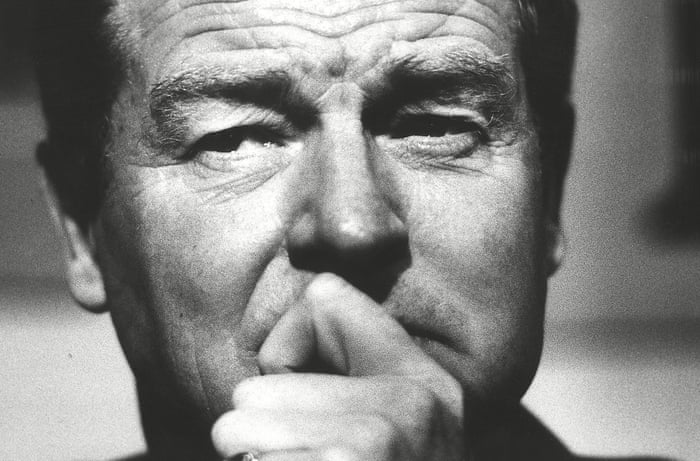
Paddy Ashdown obituary
Former leader of the Liberal Democrats who helped transform party into a British political forceStephen Bates
The Guardian
Sat 22 Dec 2018
Paddy Ashdown, who has died aged 77, was perhaps the most unlikely leader the Liberal strand of British politics has ever had. A former captain in the Royal Marines, ex-diplomat and, it was rumoured, a spy, he became the first leader of the Liberal Democrats in 1988 and led them over the next 11 years to their best electoral results at that time for three-quarters of a century. Although he never quite achieved the parliamentary breakthrough he hoped for, still less a realignment of the parties of the left in coalition with Labour, the Lib Dems became a significant and influential third force in British politics.
It was no mean achievement for a man who was regarded as uncollegiate by many of his colleagues and was a moderate speaker and poor Commons performer. What he was able to do, with hard-driving and ruthless ambition, was to turn the party from a bunch of egotistical oddballs and individualists at Westminster – in his words “a funny little herbivorous think-tank on the edges of British politics” – into a national movement that earnestly believed it could win a measure of power and convinced a swathe of the soft-left electorate that it was capable of doing so.
Square-jawed, eyes narrowed as if constantly scanning the horizon, resolutely refusing to confirm or deny that he knew how to kill a man with his bare hands from his days fighting communist insurgents in the jungles of Borneo with the Marines’ Special Boat Section, Ashdown looked like a leader of a more militant party than he actually led. If he was helped in the early 1990s by voters’ growing disillusionment with the Tories and initial reluctance in southern shire constituencies to trust Labour, he also had to overcome a ramshackle and near-bankrupt national party machine and often nonexistent local organisations.
Ashdown accomplished this despite coming from a non-liberal party background and not even having been a member of, or voting for, the party until he was in his mid-thirties. He had always been a Labour voter – not necessarily a career advantage in the officers’ mess or the diplomatic service – until being converted one day, he claimed, by a local Liberal canvasser who came knocking at his Somerset cottage door during the general election campaign in January 1974.
He recalled in his memoirs: “I definitely remember that he wore an orange anorak, looked unprepossessing and had a squeaky voice to match … My memory may be playing tricks when it tells me he also had sandals and a wispy beard. I told him pretty roughly that I certainly would not vote Liberal unless (which I considered highly unlikely) he could persuade me that I should. I don’t know quite what happened next. But two hours later, having discussed liberalism at length in our front room, I discovered that this was what I had really always been … Liberalism was an old coat that had been hanging in my cupboard … just waiting to be taken down and put on.” He was never able to track down this evangelist again.
Ashdown was the oldest of seven children, born in New Delhi, the son of John Ashdown, an Ulster Protestant who was an Indian army captain and his Ulster Catholic wife, Lois (nee Hudson), who had been an army nurse. The family did not return to Northern Ireland until after the end of the war, when his father invested his savings in a pig farm and then a market garden, both of which failed. Ashdown was christened Jeremy John Durham but gained his nickname, Paddy, from his Irish accent when his father managed to obtain a place for him at Bedford school, where he himself had been educated. The accent was soon lost, though the nickname never was, and there Ashdown obtained a military scholarship, which paid the school fees. He excelled at sport, but not academic study. He failed his French O-level, though later became proficient in several languages, including Mandarin, Hindi, Malay, Serbo-Croat, German and indeed French.
He joined the Royal Marines straight from school at about the time his parents decided to make a new life in Australia. Ashdown served for 12 years in the Marines and saw action as a commando in Kuwait, Borneo, Hong Kong and Northern Ireland where, in the early days of the Troubles, he was once required to arrest the Catholic civil rights activist and future fellow MP John Hume on the streets of Belfast. In interviews many years later, Ashdown insisted that had he been an Ulster Catholic he would probably have joined the IRA, or at least campaigned for civil rights himself.
His fluency in Chinese led to a posting with the diplomatic service, formally as first secretary to the UK’s mission to the United Nations in Geneva, where he was allegedly – Ashdown was coy on the matter – required to listen in on the conversations of the Chinese delegation and cultivate contacts. But he threw up his promising diplomatic career for family life in Norton-sub-Hamdon, a Somerset village near Yeovil with his wife, Jane, whom he had met at a military ball when he was 20, and their two small children, and joined the local Liberal association. He wrote in his memoirs that the decision was naive to the point of irresponsibility: “It just also happens to be the best decision I … made in my life.”
Ashdown was quickly chosen as the party’s candidate in a safe Tory seat and, with energy and dedication, set about reviving the moribund association and launching the sort of grassroots activist campaigns for which the Liberals later became famous: canvassing, issuing press releases, fundraising, and needling the complacent local Tories.
He spent time on the dole, but eventually managed to get a clerical job with the local Westland helicopter firm and later with the short-lived Morland sheepskin company. Then, when he and his wife got down to their last £150, they decided that he would give up political ambition and return to the Foreign Office if nothing came up within a month. They were saved by the unexpected arrival of a £1,000 grant from the Rowntree Trust, arranged by national Liberal friends.
Ashdown calculated that it would need three elections in his constituency to beat the Tories, but in the event it took only two. He was elected – one of five new Liberal MPs – in the Thatcher landslide election of 1983 and arrived at Westminster to find the party riven by personal rivalries and its alliance with the Social Democratic party, led by David Owen, growing increasingly fractious.
The parties’ failure to make a breakthrough in the 1987 general election led to the emergence of the Social and Liberal Democratic party – inevitably immediately dubbed “Salads” in the press. A name change resulted in the emergence of the Liberal Democrats, who absorbed most of the SDP remnant while shedding a few diehard Liberals. Following the resignation of the previous Liberal leader, David Steel, Ashdown won the support of 72% of the party faithful against 28% for his rival, Alan Beith. The membership was demoralised and the party was on the verge of bankruptcy, grateful for the new leader’s dynamism, but not instinctively sympathetic to someone who had only been a member for 14 years and an MP for five.
Ashdown struggled to make an impression in the chamber against Labour and Tory heckling and could be smug, humourless and patronising. “I am not a natural speaker,” he wrote in his memoirs. “I tend to speak too fast, my voice has a habit of rising in register when I am nervous. I have a poor sense of timing for jokes and I tend to lose all light and shade in my delivery when under pressure.”
Disaffected colleagues joked that the message on his answerphone said: “Please leave a message after the high moral tone.” Nor did he support all traditional Liberals’ articles of faith, proclaiming himself a multilateralist and an opponent of the proposed European takeover of Westland in his constituency. Colleagues complained that he did not think deeply about issues or listen to their views, but took off on high profile “listening to the people” nationwide tours instead.
As the 1992 general election approached, Ashdown sought an injunction against press revelations of an affair five years earlier with his former Commons secretary, Tricia Howard, which had been discovered by burglars who had broken into his solicitor’s office and stolen papers from a safe. News of the affair came out anyway, producing the memorable Sun headline “Paddy Pantsdown”. Far from the feared electoral disaster, the party’s standing in the polls went up. Ashdown’s marriage survived, but the hoped-for breakthrough at the election, leading to a realignment on the left, once more failed to materialise: the party gained just one seat, for a total of 20.
This was however followed by a series of sweeping byelection victories in safe Tory constituencies at Newbury, Christchurch and Eastleigh and before the 1997 election, Ashdown engaged in secret talks the Labour leader, Tony Blair, about forming a coalition. In the event, Blair won a landslide victory. Nevertheless, the Lib Dems gained nearly 18% of the vote and more than doubled their representation to 46 seats, their best result in more than 70 years.
By then Ashdown’s focus had shifted elsewhere, to the war in former Yugoslavia. He had first visited Sarajevo after the 1992 election to study what was happening as a former military man and grew increasingly passionate about the crisis and outraged at the west’s apparent indifference to the slaughter going on there. “It was a moral imperative, a terrible vision of the future … I was obsessed by the nightmare of it all,” he wrote. “There was this sense of guilt and anger.” His regular visits were fraught with danger and at Westminster he harried John Major’s government for its lack of action.
This took a more concrete form after he stood down from the Lib Dem leadership in 1999 and from the Commons at the general election two years later. Following the war in Kosovo, he was made high representative of the International Community and EU special representative in Bosnia and Herzegovina for four years from 2002. The role gave him plenipotentiary powers to sack politicians and even judges, to issue decrees and set up institutions from his office in Sarajevo, though supervised by the allied powers. In 2007 the British and US governments offered him a similar role in Afghanistan, but he was rejected by the Afghan president, Hamid Karzai.
Instead Ashdown remained active in Lib Dem politics. He was made a life peer in 2001 and turned to writing books: two volumes of diaries, his memoirs, A Fortunate Life, and well-received histories of incidents in the second world war: the Royal Marines’ disastrous attempt to destroy German shipping at Bordeaux in 1942 and the French resistance’s battle on the Vercours plateau in 1944. He became president of Unicef UK in 2009.
In 2015 he supervised the Lib Dems’ disastrous general election campaign, following their period of coalition with the Tories under Nick Clegg’s leadership, which saw them lose 49 of their 57 seats. He revealed, in November of this year, that he had been diagnosed with bladder cancer. “I have known for about three weeks that I am suffering from a cancer of the bladder,” he told Somerset Live. “I’m being effectively and wonderfully looked after by everyone at Yeovil hospital.”
He had told the Observer in 2013 that he was not sad never to have been prime minister: “Not really, not any longer. Am I proud to have been the founder leader of a party that survived against the odds and has done bloody well in the first coalition government at an exceedingly difficult time? Yeah, I burn with pride about that.”
He is survived by Jane and their daughter, Kate and son, Simon.
• Jeremy John Durham (Paddy) Ashdown, Lord Ashdown of Norton-sub-Hamdon, born 27 February 1941; died 22 December 2018.
Sat 22 Dec 2018
Paddy Ashdown, who has died aged 77, was perhaps the most unlikely leader the Liberal strand of British politics has ever had. A former captain in the Royal Marines, ex-diplomat and, it was rumoured, a spy, he became the first leader of the Liberal Democrats in 1988 and led them over the next 11 years to their best electoral results at that time for three-quarters of a century. Although he never quite achieved the parliamentary breakthrough he hoped for, still less a realignment of the parties of the left in coalition with Labour, the Lib Dems became a significant and influential third force in British politics.
It was no mean achievement for a man who was regarded as uncollegiate by many of his colleagues and was a moderate speaker and poor Commons performer. What he was able to do, with hard-driving and ruthless ambition, was to turn the party from a bunch of egotistical oddballs and individualists at Westminster – in his words “a funny little herbivorous think-tank on the edges of British politics” – into a national movement that earnestly believed it could win a measure of power and convinced a swathe of the soft-left electorate that it was capable of doing so.
Square-jawed, eyes narrowed as if constantly scanning the horizon, resolutely refusing to confirm or deny that he knew how to kill a man with his bare hands from his days fighting communist insurgents in the jungles of Borneo with the Marines’ Special Boat Section, Ashdown looked like a leader of a more militant party than he actually led. If he was helped in the early 1990s by voters’ growing disillusionment with the Tories and initial reluctance in southern shire constituencies to trust Labour, he also had to overcome a ramshackle and near-bankrupt national party machine and often nonexistent local organisations.
Ashdown accomplished this despite coming from a non-liberal party background and not even having been a member of, or voting for, the party until he was in his mid-thirties. He had always been a Labour voter – not necessarily a career advantage in the officers’ mess or the diplomatic service – until being converted one day, he claimed, by a local Liberal canvasser who came knocking at his Somerset cottage door during the general election campaign in January 1974.
He recalled in his memoirs: “I definitely remember that he wore an orange anorak, looked unprepossessing and had a squeaky voice to match … My memory may be playing tricks when it tells me he also had sandals and a wispy beard. I told him pretty roughly that I certainly would not vote Liberal unless (which I considered highly unlikely) he could persuade me that I should. I don’t know quite what happened next. But two hours later, having discussed liberalism at length in our front room, I discovered that this was what I had really always been … Liberalism was an old coat that had been hanging in my cupboard … just waiting to be taken down and put on.” He was never able to track down this evangelist again.
Ashdown was the oldest of seven children, born in New Delhi, the son of John Ashdown, an Ulster Protestant who was an Indian army captain and his Ulster Catholic wife, Lois (nee Hudson), who had been an army nurse. The family did not return to Northern Ireland until after the end of the war, when his father invested his savings in a pig farm and then a market garden, both of which failed. Ashdown was christened Jeremy John Durham but gained his nickname, Paddy, from his Irish accent when his father managed to obtain a place for him at Bedford school, where he himself had been educated. The accent was soon lost, though the nickname never was, and there Ashdown obtained a military scholarship, which paid the school fees. He excelled at sport, but not academic study. He failed his French O-level, though later became proficient in several languages, including Mandarin, Hindi, Malay, Serbo-Croat, German and indeed French.
He joined the Royal Marines straight from school at about the time his parents decided to make a new life in Australia. Ashdown served for 12 years in the Marines and saw action as a commando in Kuwait, Borneo, Hong Kong and Northern Ireland where, in the early days of the Troubles, he was once required to arrest the Catholic civil rights activist and future fellow MP John Hume on the streets of Belfast. In interviews many years later, Ashdown insisted that had he been an Ulster Catholic he would probably have joined the IRA, or at least campaigned for civil rights himself.
His fluency in Chinese led to a posting with the diplomatic service, formally as first secretary to the UK’s mission to the United Nations in Geneva, where he was allegedly – Ashdown was coy on the matter – required to listen in on the conversations of the Chinese delegation and cultivate contacts. But he threw up his promising diplomatic career for family life in Norton-sub-Hamdon, a Somerset village near Yeovil with his wife, Jane, whom he had met at a military ball when he was 20, and their two small children, and joined the local Liberal association. He wrote in his memoirs that the decision was naive to the point of irresponsibility: “It just also happens to be the best decision I … made in my life.”
Ashdown was quickly chosen as the party’s candidate in a safe Tory seat and, with energy and dedication, set about reviving the moribund association and launching the sort of grassroots activist campaigns for which the Liberals later became famous: canvassing, issuing press releases, fundraising, and needling the complacent local Tories.
He spent time on the dole, but eventually managed to get a clerical job with the local Westland helicopter firm and later with the short-lived Morland sheepskin company. Then, when he and his wife got down to their last £150, they decided that he would give up political ambition and return to the Foreign Office if nothing came up within a month. They were saved by the unexpected arrival of a £1,000 grant from the Rowntree Trust, arranged by national Liberal friends.
Ashdown calculated that it would need three elections in his constituency to beat the Tories, but in the event it took only two. He was elected – one of five new Liberal MPs – in the Thatcher landslide election of 1983 and arrived at Westminster to find the party riven by personal rivalries and its alliance with the Social Democratic party, led by David Owen, growing increasingly fractious.
The parties’ failure to make a breakthrough in the 1987 general election led to the emergence of the Social and Liberal Democratic party – inevitably immediately dubbed “Salads” in the press. A name change resulted in the emergence of the Liberal Democrats, who absorbed most of the SDP remnant while shedding a few diehard Liberals. Following the resignation of the previous Liberal leader, David Steel, Ashdown won the support of 72% of the party faithful against 28% for his rival, Alan Beith. The membership was demoralised and the party was on the verge of bankruptcy, grateful for the new leader’s dynamism, but not instinctively sympathetic to someone who had only been a member for 14 years and an MP for five.
Ashdown struggled to make an impression in the chamber against Labour and Tory heckling and could be smug, humourless and patronising. “I am not a natural speaker,” he wrote in his memoirs. “I tend to speak too fast, my voice has a habit of rising in register when I am nervous. I have a poor sense of timing for jokes and I tend to lose all light and shade in my delivery when under pressure.”
Disaffected colleagues joked that the message on his answerphone said: “Please leave a message after the high moral tone.” Nor did he support all traditional Liberals’ articles of faith, proclaiming himself a multilateralist and an opponent of the proposed European takeover of Westland in his constituency. Colleagues complained that he did not think deeply about issues or listen to their views, but took off on high profile “listening to the people” nationwide tours instead.
As the 1992 general election approached, Ashdown sought an injunction against press revelations of an affair five years earlier with his former Commons secretary, Tricia Howard, which had been discovered by burglars who had broken into his solicitor’s office and stolen papers from a safe. News of the affair came out anyway, producing the memorable Sun headline “Paddy Pantsdown”. Far from the feared electoral disaster, the party’s standing in the polls went up. Ashdown’s marriage survived, but the hoped-for breakthrough at the election, leading to a realignment on the left, once more failed to materialise: the party gained just one seat, for a total of 20.
This was however followed by a series of sweeping byelection victories in safe Tory constituencies at Newbury, Christchurch and Eastleigh and before the 1997 election, Ashdown engaged in secret talks the Labour leader, Tony Blair, about forming a coalition. In the event, Blair won a landslide victory. Nevertheless, the Lib Dems gained nearly 18% of the vote and more than doubled their representation to 46 seats, their best result in more than 70 years.
By then Ashdown’s focus had shifted elsewhere, to the war in former Yugoslavia. He had first visited Sarajevo after the 1992 election to study what was happening as a former military man and grew increasingly passionate about the crisis and outraged at the west’s apparent indifference to the slaughter going on there. “It was a moral imperative, a terrible vision of the future … I was obsessed by the nightmare of it all,” he wrote. “There was this sense of guilt and anger.” His regular visits were fraught with danger and at Westminster he harried John Major’s government for its lack of action.
This took a more concrete form after he stood down from the Lib Dem leadership in 1999 and from the Commons at the general election two years later. Following the war in Kosovo, he was made high representative of the International Community and EU special representative in Bosnia and Herzegovina for four years from 2002. The role gave him plenipotentiary powers to sack politicians and even judges, to issue decrees and set up institutions from his office in Sarajevo, though supervised by the allied powers. In 2007 the British and US governments offered him a similar role in Afghanistan, but he was rejected by the Afghan president, Hamid Karzai.
Instead Ashdown remained active in Lib Dem politics. He was made a life peer in 2001 and turned to writing books: two volumes of diaries, his memoirs, A Fortunate Life, and well-received histories of incidents in the second world war: the Royal Marines’ disastrous attempt to destroy German shipping at Bordeaux in 1942 and the French resistance’s battle on the Vercours plateau in 1944. He became president of Unicef UK in 2009.
In 2015 he supervised the Lib Dems’ disastrous general election campaign, following their period of coalition with the Tories under Nick Clegg’s leadership, which saw them lose 49 of their 57 seats. He revealed, in November of this year, that he had been diagnosed with bladder cancer. “I have known for about three weeks that I am suffering from a cancer of the bladder,” he told Somerset Live. “I’m being effectively and wonderfully looked after by everyone at Yeovil hospital.”
He had told the Observer in 2013 that he was not sad never to have been prime minister: “Not really, not any longer. Am I proud to have been the founder leader of a party that survived against the odds and has done bloody well in the first coalition government at an exceedingly difficult time? Yeah, I burn with pride about that.”
He is survived by Jane and their daughter, Kate and son, Simon.
• Jeremy John Durham (Paddy) Ashdown, Lord Ashdown of Norton-sub-Hamdon, born 27 February 1941; died 22 December 2018.
Saturday, 22 December 2018
Friday, 21 December 2018
Thursday, 20 December 2018
Paddy McAloon talks I Trawl the Megahertz, Spike Lee and Femmes Mythologiques...
Listen here -
while you can: https://www.bbc.co.uk/sounds/play/p06vhcgs
Tuesday, 18 December 2018
Marty Stuart and his Fabulous Superlatives at The Split Chimp, Newcastle
His album, Way Out West, is pretty damn good too...
Monday, 17 December 2018
Sunday, 16 December 2018
Saturday, 15 December 2018
Jane Dickson in Times Square
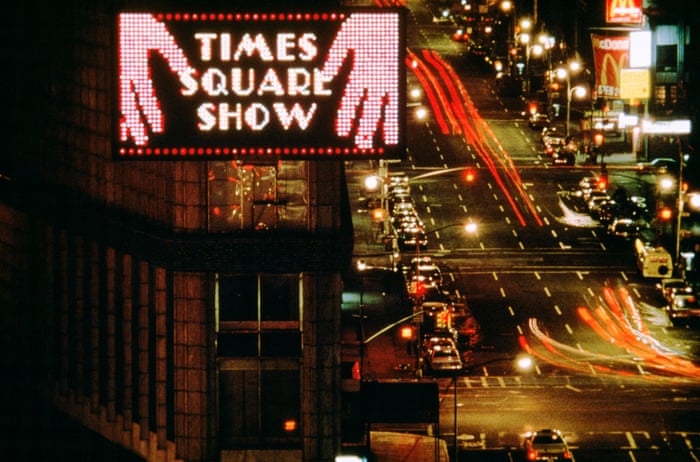
Sleaze, hustlers and strippers: Jane Dickson's lost Times Square
Living and working in the grimy heart of 70s New York, Dickson’s photographs and paintings gave a close-up view of the nocturnal activities that made the place so notorious – and alluring
Sean O'Hagan
The Guardian
Tue 13 Nov 2018
In 1978, Jane Dickson answered a job advert in the New York Times that read: “Artist wanted, willing to learn computers.” Soon afterwards, she was hired to work on the first digital light Spectacolor billboard on Times Square.
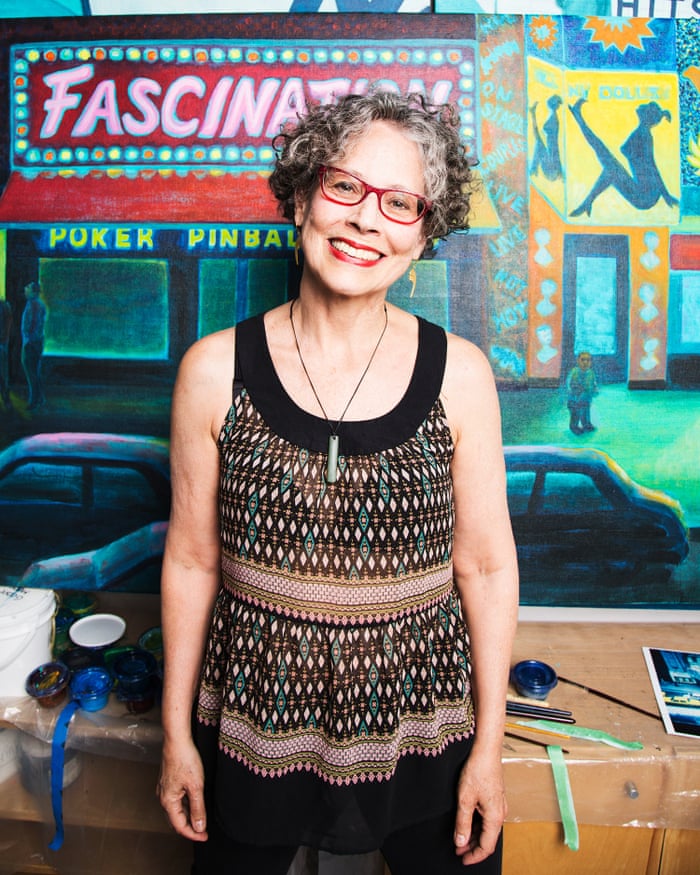

Jane Dickson
“I sat in an office on the third floor of a building just behind the giant screen,” she recalls. “I mainly worked night shifts at the weekend, programming the digitally animated visuals and, for the first few years, I ran the countdown for New Year’s Eve. That was my introduction to Times Square after dark. It really couldn’t have been more exciting or surreal.
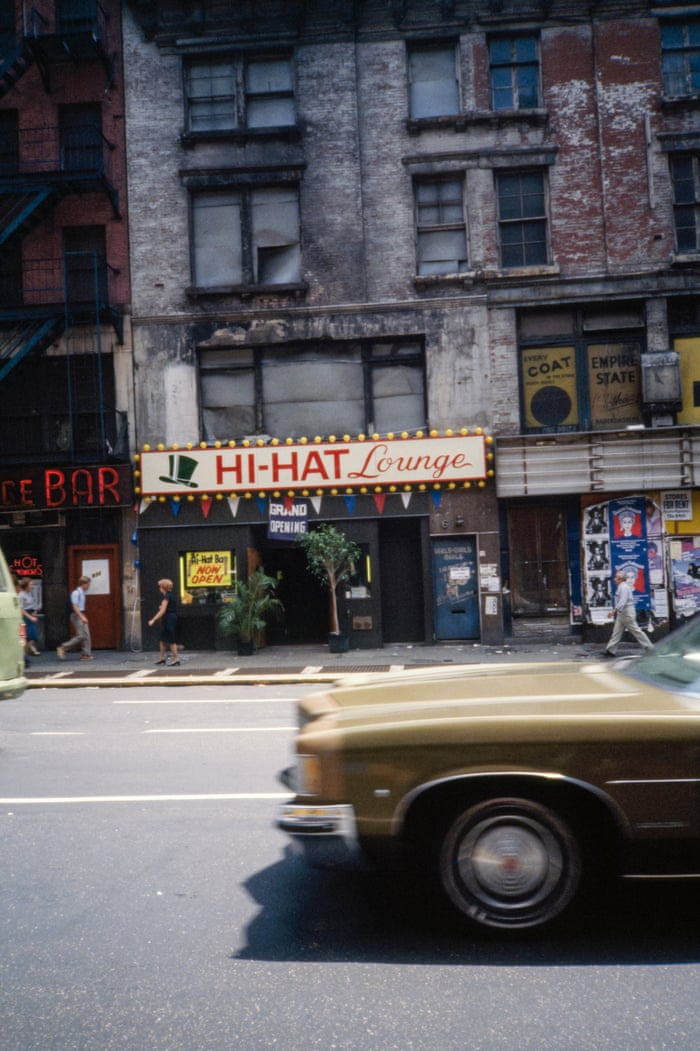
View on Eighth Avenue between 40th and 41st Streets
Primarily known as a painter, Dickson initially gained recognition as a member of Colab, a loosely affiliated bunch of late-70s downtown New York artists who included Jenny Holzer, Kiki Smith and the underground film-maker Charlie Ahearn, Dickson’s husband. The sketches she made from behind the giant screen were the basis for several darkly evocative sets of later paintings that capture the neon-lit atmosphere of Times Square in the 70s.
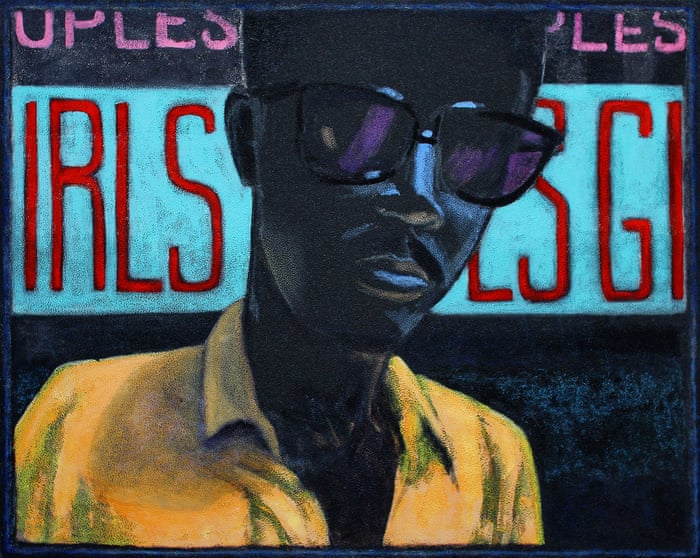
Fred (1983)
Dickson also created a huge archive of everyday images from 1978 to 1984 that are an impressionistic record of a vibrant cultural moment just before the old, seedy Times Square disappeared for ever. In a new book, Jane Dickson in Times Square, her paintings are shown for the first time alongside photographs she also took back then. “I am just beginning to see them as an art project in themselves,” she says. “Maybe part of their charm is that they were not artful.”
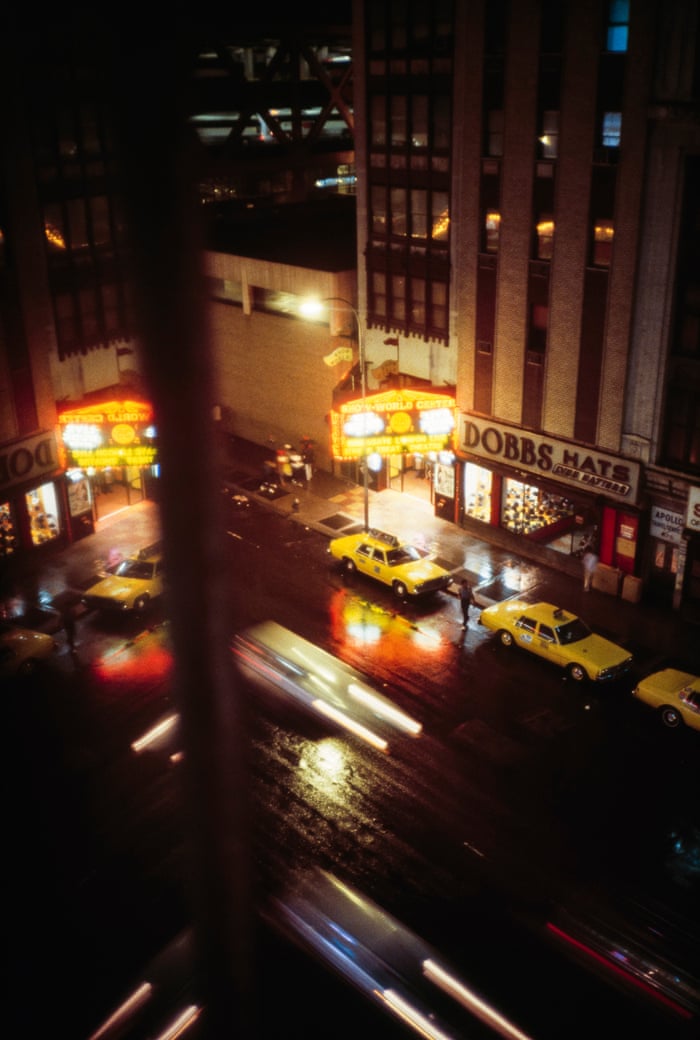
Unsurprisingly, they possess a painterly quality, the dazzle of neon and blur of people on the move lending a kind of hallucinatory haze to the thriving nocturnal streets. “Baudelaire said an artist must be of their time and, to do that, they should walk the streets,” says Dickson. “Often I was having palpitations. Any city at night is dangerous for a woman, but Times Square and the streets around it had this almost seductive glow. They were glitteringly attractive in a visual way. I tend to make paintings of the things that I am afraid of. That’s why they are so vivid.”
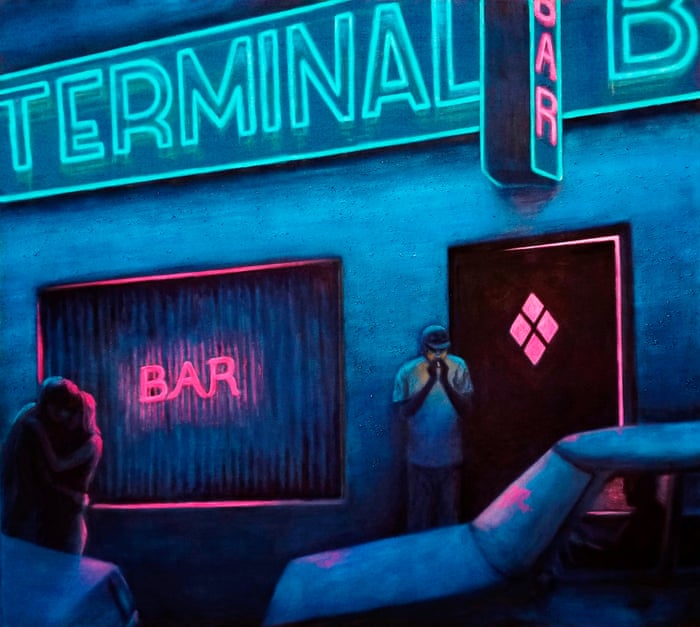
Terminal Bar 2 (2017)
Dickson’s photographs chronicle a harsher but hipper New York than today, when artists were outsiders rather than careerists and sleaze was peddled openly to tourists at strip clubs and porn stores such as Peepland and XXXtasy. The edgy, nocturnal energy of those midtown streets also fascinated Diane Arbus, who photographed its denizens a decade before, and Lou Reed, whose songs hymned the city’s pimps, hustlers, drug dealers and transvestites. In the early 70s, the novelist Kathy Acker hung out at Tad’s Steaks between performing in a live sex show with her boyfriend at a Times Square venue called Fun City.
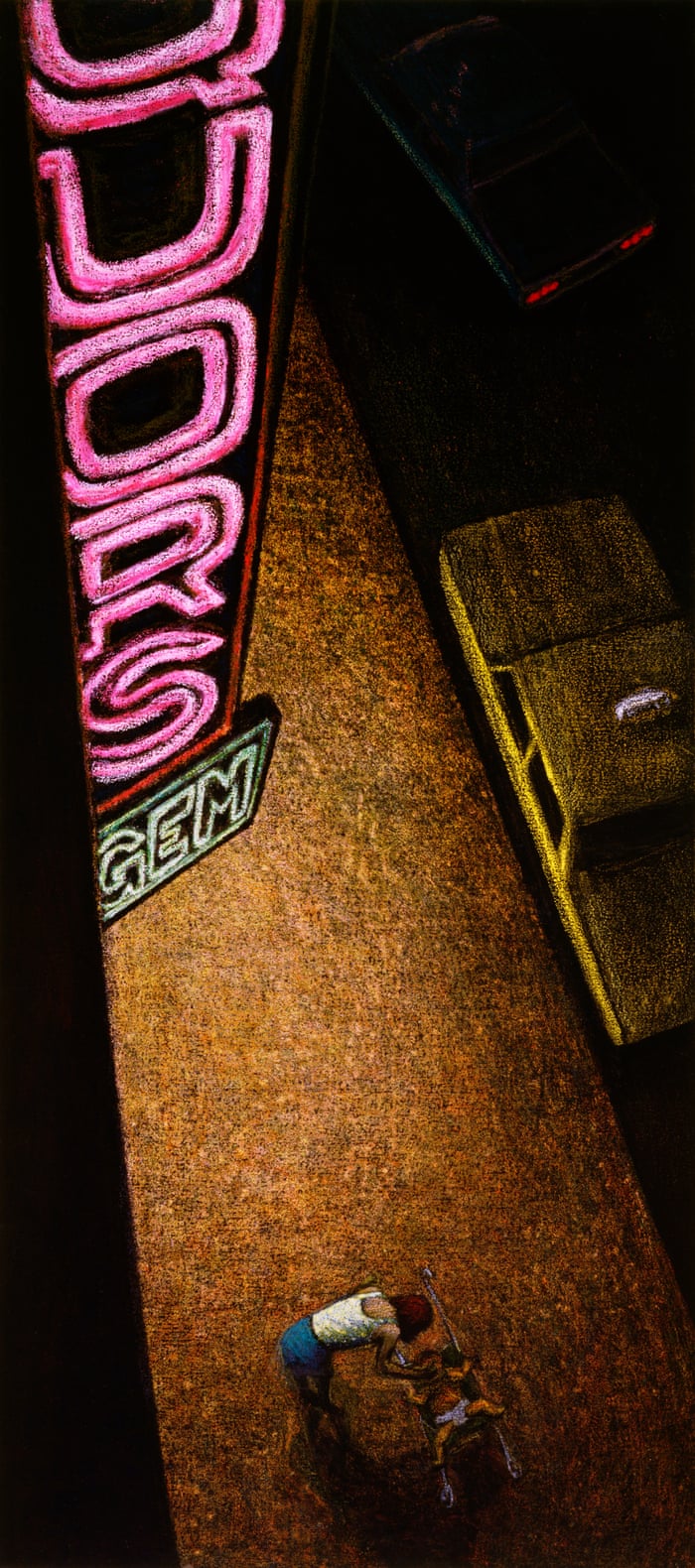
Liquors, 1984
“I had friends who worked in strip clubs to pay the rent or to go through college,” says Dickson. “The art scene was a bit more gritty back then, and everyone lived a wilder life. I got to know girls who really didn’t like you to take photos unless they were being paid. Almost everyone who worked in and around Times Square was a hustler of one kind or another.”
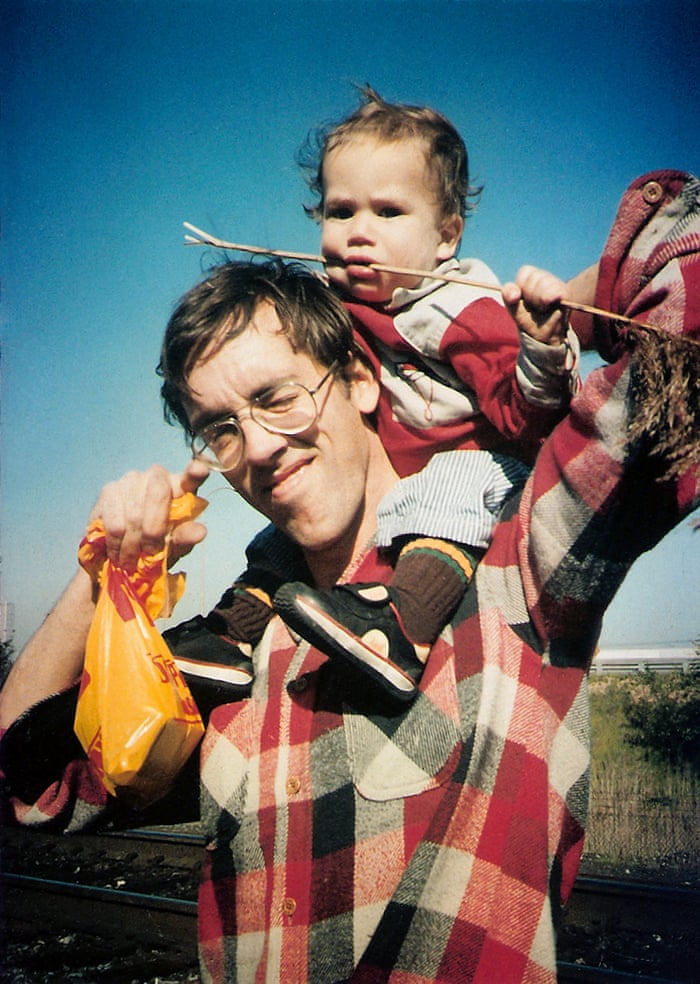

Dickson’s photograph of David Wojnarowicz, one of her artist friends
Born in Chicago, Dickson arrived in New York in 1977 and became part of a scene that included artists, film-makers, photographers and punk musicians. Her book includes portraits of many of her friends and fellow artists, including Nan Goldin (whose street portrait of Dickson is on the cover), film-maker Vivienne Dick, hip-hop and graffiti pioneer Fab 5 Freddy Braithwaite, artist David Wojnarowicz and photographer Peter Hujar. The writer Chris Kraus, also part of the scene, has written the introduction. “Back then, Times Square was a kind of mecca for the hip and the curious because it was a crazy place, so full of dark energy.” says Dickson. “I photographed them all as friends, but, even back then, it was also clear to me that I was living in an extraordinarily creative period with a very gifted group of people.”
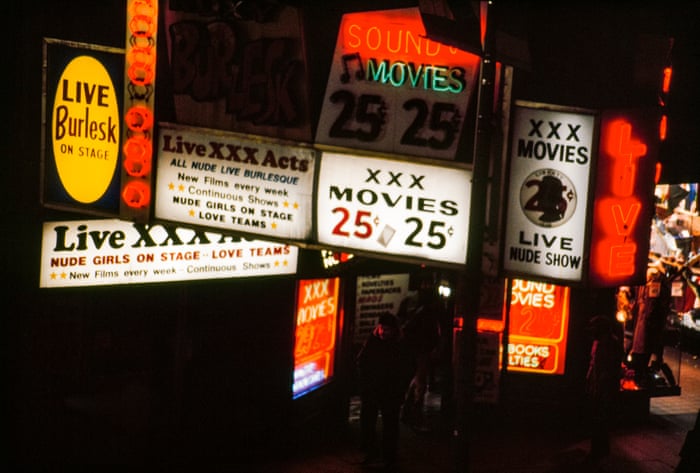
In January 1981, Dickson and her husband moved into a loft overlooking Times Square because the downtown neighbourhood they had been living in had become “too rough, too dangerous after dark”. The neighbourhood in question was Tribeca, now one of the most sought-after parts of Manhattan, populated with celebrities like Taylor Swift and Robert De Niro - “I saw him recently on a corner waiting for a limo,” says Dickson.
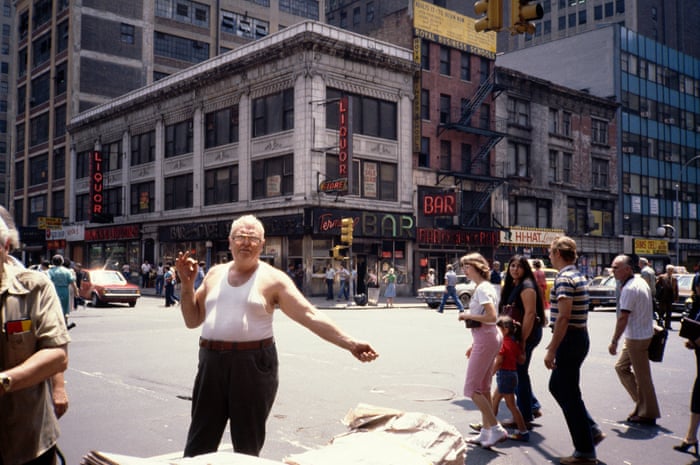
View of Hi-Hat and Terminal Bar, Eighth Avenue and 41st Street
Through the window of her apartment, Dickson also began to photograph the daily street hustle from above. Using colour slide film, she captured an illuminated shadowland of strip joints, peep shows, all-night cinemas, sex shops and liquor stores. Sometimes, she pointed the camera at the windows that overlooked her apartment, using the photographs for a later series of paintings, entitled Witness.
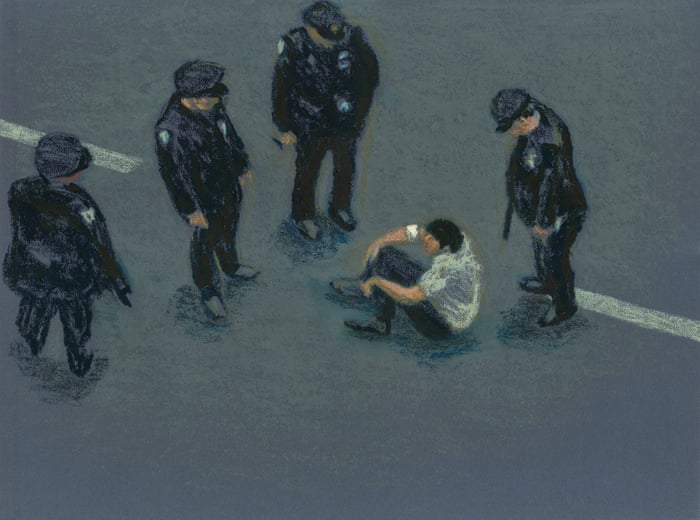
“I was interested in the surveillance aspect. In the strip joints, I’d sometimes photographed furtive men who really did not want to be photographed. From my window, I could see the Times Square Motor Hotel, which was single room occupancy and housed a transient clientele who were involved in various hustles. It was risky. On two occasions someone shot through the window of our loft.”
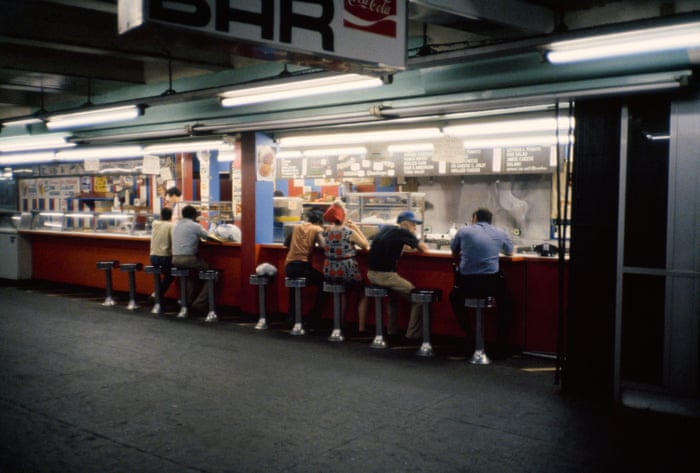

View of Times Square subway lunch counter near Broadway and 42nd Street
For all that, she recalls that younger, wilder period of her life as “an electric time”, a description borne out by her vibrant, impressionistic photographs, made without a thought for their artistic worth. “I wanted to capture things that were passing quickly,” she says. “Things that were glittery, exciting, but a little bit out of control. I thought of myself very much as an artist of the everyday. Now my everyday is history. It’s kind of depressing.”
Jane Dickson in Times Square is published by Anthology Editions.
Jane Dickson in Times Square is published by Anthology Editions.
Friday, 14 December 2018
Seth Lakeman meets Izzy Young, the folklorist of Greenwich Village
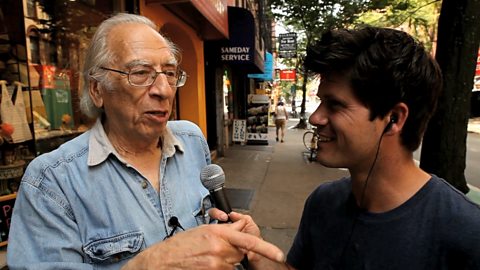
One of the UK's most acclaimed folk singers, Seth Lakeman, travels to New York to meet the man regarded as the world's leading expert on folk music, 85-year-old Izzy Young, who opened his first Folklore Center in New York's Greenwich Village in 1957.
The store in MacDougal St became a focal point for the American folk music scene of the time. Bob Dylan writes in his memoirs about spending time at the Center, which he referred to as "The citadel of Americana Folk Music - like an ancient chapel". Dylan met Dave Van Ronk in the store, and Izzy Young produced Dylan's first concert at Carnegie Chapter Hall in 1961. Dylan wrote a song about the store and Young called "Talking Folklore Center".
After developing an interest in Swedish folk music at a festival, Young closed his New York store and in 1973 he moved to Stockholm where he opened the Folklore Centrum, where he still works seven days a week.
Making a rare return to New York, 40 years since he first left, Izzy joins Seth on the steps of 110 MacDougal St in Greenwich Village - the site of his original Folklore Center – to reminisce about the evocative days in the late 50s and early 60s when, as Bob Dylan recalls, "Folk music glittered like a mound of gold".
Wandering up MacDougal Street to Washington Square Park, Izzy describes the events of April 1961, when `Folkies' staged what would later be referred to as `the first protest action of the 60s'. When city officials tried to ban folk musicians from performing in the square, Izzy was the main organiser of a protest that resulted in clashes with local police. The protestors eventually won their legal battle with the city and music has been permitted in the square ever since.
Producer: Des Shaw
A Ten Alps production for BBC Radio 4
Catch it now or over the next 28 days at https://www.bbc.co.uk/programmes/b0381fzj
Thursday, 13 December 2018
Tuesday, 11 December 2018
Pete Shelley RIP

Lead singer of the 70s punk band Buzzcocks whose subtle, witty songs still sound fresh and inventive
Adam Sweeting
The Guardian
Fri 7 Dec 2018
Pete Shelley and his band Buzzcocks became indelibly linked to the UK’s punk movement when they played their first gig supporting the Sex Pistols at the Lesser Free Trade Hall in Manchester in July 1976, but they never conformed to any of punk’s cliches about rage, anarchy and rebellion. Shelley, who has died of a heart attack aged 63, proved to be a songwriter of wit and subtlety, able to probe the angst and confusion of adolescent love and lust with shrewd insight.
He was innovative musically as well as lyrically, taking inspiration from David Bowie, Brian Eno, Roxy Music and the Velvet Underground, as well as from German bands such as Neu and Can. While the music of many of the punk bands remains firmly of its time, Buzzcocks’ best songs still sound fresh and inventive, mixing dense guitar patterns with infectious melodies. Their influence can be heard on bands from Primal Scream and the Jesus and Mary Chain to REM and Nirvana. Gary Kemp of Spandau Ballet said: “Pete was one of Britain’s best pure pop writers, up there with Ray Davies.”
Buzzcocks achieved success with their first recording, the Spiral Scratch EP, which was released on their own label, New Hormones, in January 1977 (the band having supported the Sex Pistols on their Anarchy tour in late 1976). It was one of the first independent releases of the punk era, and to the band’s surprise sold its first thousand copies in four days. “We made quite a bit of money from Spiral Scratch,” Shelley recalled. “It ended up selling about 16,000 copies and we were able to buy some new equipment.”
They then signed to United Artists. Their first single, Orgasm Addict, was released in November 1977 but the BBC declined to play it because of its subject matter and it did not make the charts. The follow-up, What Do I Get, released in February 1978, reached 37, and their debut album, Another Music in a Different Kitchen (1978) climbed to 15. Their second album, Love Bites, which came out later that year, contained what remains their best-known hit, the zingingly propulsive Ever Fallen In Love (With Someone You Shouldn’t’ve), which made No 12. Shelley borrowed the title from a line in the musical Guys and Dolls. The 1979 album A Different Kind of Tension reached 26 in the UK.
Continued singles success came with Promises (20), Everybody’s Happy Nowadays (29) and Harmony in My Head (32). However, growing tensions in the band coupled with friction with EMI, which had purchased United Artists, prompted Shelley to break up Buzzcocks in 1981.
He was born Peter McNeish in Leigh, Lancashire. His father, John, was a fitter at Astley Green colliery, and his mother, Margaret, a former mill worker. Peter began writing songs while still at Leigh grammar school, and while studying for an HND in electronics at Bolton Institute of Technology he bought a Tandberg four-track reel-to-reel tape recorder and began making recordings of his own songs. (“I think of my career in music more as a songwriting career than anything else,” he said in 1983.) He formed a group called Jets of Air, the name inspired by a college lecture on Newtonian physics, and while “we played only about six gigs in three years”, Shelley built up a stockpile of songs.
He then dabbled in a project called Sky, where he experimented with electronic music and recorded the album Sky Yen, released later, in 1980, on his own label, Groovy Records. He subsequently tried making “heavier, more rhythmic” music with Smash, which he described as “a non-existent group”, but which supplied more raw material for Buzzcocks.
The band came about when Shelley spotted an advertisement on a college noticeboard from Howard Devoto (real name Howard Trafford), wanting to form a band in the vein of the Stooges and the Velvet Underground. “That was much in line with the Smash idea, so I phoned him up straight away,” said Shelley. Buzzcocks originally planned to make their debut at the first Sex Pistols concert at the Lesser Free Trade Hall in June 1976, but the bass player and drummer pulled out.
For their eventual appearance the following month, Shelley and Devoto were joined by the drummer John Maher and the bassist Steve Diggle. When Devoto quit after the release of Spiral Scratch and went on to form Magazine, Shelley became lead vocalist, Diggle switched to guitar and the original bass player, Garth Smith, rejoined temporarily, later replaced by Steve Garvey.
In 1981 Shelley launched his solo career with the single Homosapien, from the album of the same name, produced by the Buzzcocks producer Martin Rushent (who was about to help make Human League’s electropop epic Dare). Shelley had returned to his earlier fondness for electronica, and found himself in controversial waters when the BBC banned Homosapien for its “explicit reference to gay sex”. In 2002 Shelley commented that his sexuality “tends to change as much as the weather”. The track reached 14 on the US dance chart.
In 1983 his second solo album, XL1, brought him a minor hit single with Telephone Operator. In 1987 he contributed the song Do Anything to the soundtrack of the John Hughes movie Some Kind of Wonderful.
In 1989 Buzzcocks reformed and toured the US, and released Trade Test Transmissions (1993), the first of a series of albums, the most recent of which was The Way (2014). In 2002, Shelley reunited with Devoto to record the album Buzzkunst. “Devoto is not the life and soul of the party or a born raconteur, but he sees things as funny and I think that’s how we hit it off with each other,” Shelley observed drily. “I always had this idea that me and Devoto were like Gilbert and George. As long as you approach it from that angle you can do anything you want, and you just call it art.”
In 2005, following the death of the DJ John Peel, Shelley recorded a tribute version of Ever Fallen In Love with a multi-platinum lineup of stars including Elton John, Robert Plant, David Gilmour and Roger Daltrey.
In 2012 he moved to Tallinn, Estonia, with his second wife, Greta. She survives him, as do his younger brother, Gary, and a son from his first marriage.
• Pete Shelley (Peter Campbell McNeish), musician, singer and songwriter, born 17 April 1955; died 6 December 2018
Fri 7 Dec 2018
Pete Shelley and his band Buzzcocks became indelibly linked to the UK’s punk movement when they played their first gig supporting the Sex Pistols at the Lesser Free Trade Hall in Manchester in July 1976, but they never conformed to any of punk’s cliches about rage, anarchy and rebellion. Shelley, who has died of a heart attack aged 63, proved to be a songwriter of wit and subtlety, able to probe the angst and confusion of adolescent love and lust with shrewd insight.
He was innovative musically as well as lyrically, taking inspiration from David Bowie, Brian Eno, Roxy Music and the Velvet Underground, as well as from German bands such as Neu and Can. While the music of many of the punk bands remains firmly of its time, Buzzcocks’ best songs still sound fresh and inventive, mixing dense guitar patterns with infectious melodies. Their influence can be heard on bands from Primal Scream and the Jesus and Mary Chain to REM and Nirvana. Gary Kemp of Spandau Ballet said: “Pete was one of Britain’s best pure pop writers, up there with Ray Davies.”
Buzzcocks achieved success with their first recording, the Spiral Scratch EP, which was released on their own label, New Hormones, in January 1977 (the band having supported the Sex Pistols on their Anarchy tour in late 1976). It was one of the first independent releases of the punk era, and to the band’s surprise sold its first thousand copies in four days. “We made quite a bit of money from Spiral Scratch,” Shelley recalled. “It ended up selling about 16,000 copies and we were able to buy some new equipment.”
They then signed to United Artists. Their first single, Orgasm Addict, was released in November 1977 but the BBC declined to play it because of its subject matter and it did not make the charts. The follow-up, What Do I Get, released in February 1978, reached 37, and their debut album, Another Music in a Different Kitchen (1978) climbed to 15. Their second album, Love Bites, which came out later that year, contained what remains their best-known hit, the zingingly propulsive Ever Fallen In Love (With Someone You Shouldn’t’ve), which made No 12. Shelley borrowed the title from a line in the musical Guys and Dolls. The 1979 album A Different Kind of Tension reached 26 in the UK.
Continued singles success came with Promises (20), Everybody’s Happy Nowadays (29) and Harmony in My Head (32). However, growing tensions in the band coupled with friction with EMI, which had purchased United Artists, prompted Shelley to break up Buzzcocks in 1981.
He was born Peter McNeish in Leigh, Lancashire. His father, John, was a fitter at Astley Green colliery, and his mother, Margaret, a former mill worker. Peter began writing songs while still at Leigh grammar school, and while studying for an HND in electronics at Bolton Institute of Technology he bought a Tandberg four-track reel-to-reel tape recorder and began making recordings of his own songs. (“I think of my career in music more as a songwriting career than anything else,” he said in 1983.) He formed a group called Jets of Air, the name inspired by a college lecture on Newtonian physics, and while “we played only about six gigs in three years”, Shelley built up a stockpile of songs.
He then dabbled in a project called Sky, where he experimented with electronic music and recorded the album Sky Yen, released later, in 1980, on his own label, Groovy Records. He subsequently tried making “heavier, more rhythmic” music with Smash, which he described as “a non-existent group”, but which supplied more raw material for Buzzcocks.
The band came about when Shelley spotted an advertisement on a college noticeboard from Howard Devoto (real name Howard Trafford), wanting to form a band in the vein of the Stooges and the Velvet Underground. “That was much in line with the Smash idea, so I phoned him up straight away,” said Shelley. Buzzcocks originally planned to make their debut at the first Sex Pistols concert at the Lesser Free Trade Hall in June 1976, but the bass player and drummer pulled out.
For their eventual appearance the following month, Shelley and Devoto were joined by the drummer John Maher and the bassist Steve Diggle. When Devoto quit after the release of Spiral Scratch and went on to form Magazine, Shelley became lead vocalist, Diggle switched to guitar and the original bass player, Garth Smith, rejoined temporarily, later replaced by Steve Garvey.
In 1981 Shelley launched his solo career with the single Homosapien, from the album of the same name, produced by the Buzzcocks producer Martin Rushent (who was about to help make Human League’s electropop epic Dare). Shelley had returned to his earlier fondness for electronica, and found himself in controversial waters when the BBC banned Homosapien for its “explicit reference to gay sex”. In 2002 Shelley commented that his sexuality “tends to change as much as the weather”. The track reached 14 on the US dance chart.
In 1983 his second solo album, XL1, brought him a minor hit single with Telephone Operator. In 1987 he contributed the song Do Anything to the soundtrack of the John Hughes movie Some Kind of Wonderful.
In 1989 Buzzcocks reformed and toured the US, and released Trade Test Transmissions (1993), the first of a series of albums, the most recent of which was The Way (2014). In 2002, Shelley reunited with Devoto to record the album Buzzkunst. “Devoto is not the life and soul of the party or a born raconteur, but he sees things as funny and I think that’s how we hit it off with each other,” Shelley observed drily. “I always had this idea that me and Devoto were like Gilbert and George. As long as you approach it from that angle you can do anything you want, and you just call it art.”
In 2005, following the death of the DJ John Peel, Shelley recorded a tribute version of Ever Fallen In Love with a multi-platinum lineup of stars including Elton John, Robert Plant, David Gilmour and Roger Daltrey.
In 2012 he moved to Tallinn, Estonia, with his second wife, Greta. She survives him, as do his younger brother, Gary, and a son from his first marriage.
• Pete Shelley (Peter Campbell McNeish), musician, singer and songwriter, born 17 April 1955; died 6 December 2018
Monday, 10 December 2018
Jazz on the Tyne
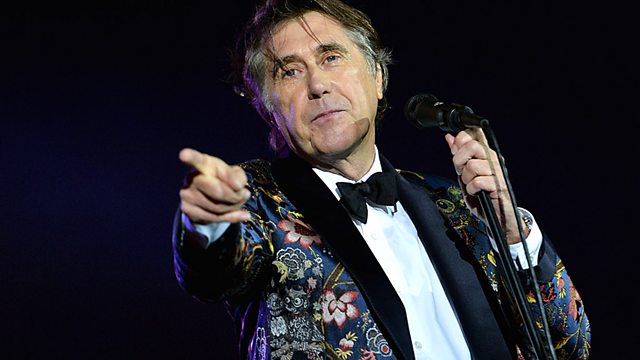
In 1955 at the age of ten, Bryan Ferry developed a passion for jazz music. Listening to his radio in Washington, County Durham, he was transported from rural North East England to 1920s New Orleans and Cotton Club, New York. British Trad Jazz was booming, with Humphrey Lyttelton, Chris Barber and Ken Collier offering a gateway to the 'yellow cocktail' music of Louis Armstrong, Duke Ellington and Charlie Parker.
Now Bryan has returned to his earliest musical love with 'The Jazz Age', a record that remakes and remodels some of his biggest Roxy Music hits in the style of instrumental 20s jazz standards.
Bryan takes us back to his first concert at Newcastle City Hall to see the Chris Barber band and reveals how a performance of St Louis Blues caught his imagination. Trombonist Chris Barber describes how he brought music from the Deep South to rapturous British audiences.
Newcastle music historian Chris Phipps traces the mythical connection between the Mississippi and the Tyne, while Bryan shares his memories of a vibrant, modernist city where he studied fine art. The city still shows traces of its jazz heritage, including J G Windows, the record shop where Bryan bought his 78s including the Charlie Parker Quintet's EP whose solos he learnt by heart.
It wasn't just the jazz age of the 20s that inspired Bryan, but its literature too. He recently contributed to the soundtrack of Baz Luhrmann's Great Gatsby, the film of one of his favourite novels.
With live recordings from his recent UK tour with The Bryan Ferry Jazz Orchestra, Bryan reflects on Roxy Music's early years and explains how his grounding in jazz helped him lead one of the most influential British bands of all time.
Producer: Paul Smith
A Just Radio production for BBC Radio 4
Listen for the next 27 days: https://www.bbc.co.uk/programmes/b03kpy59
Still doesn't explain why he sings the way he does, though...
Still doesn't explain why he sings the way he does, though...
Sunday, 9 December 2018
Saturday, 8 December 2018
The Beach Boys: Wake the World and I Can Hear Music - 1968 copyright extension releases

Wake The World: The Beach Boys Mine 1968 Vaults for Two New Copyright Extension Titles!
Sam Stone
The Second Disc
7 December 2018
It’s become something of an annual tradition, The Beach Boys’ copyright extension releases that offer a welcome musical reprieve from the wintery chill outside. Since 2013, The Beach Boys have released rarities from the vault in order to secure the recordings’ copyright. As a result, fans have been treated to live rarities from their earliest years, stripped-down sessions, and most recently, outtakes from their Smiley Smile and Wild Honey albums. Now, the time has come again for two more installments! Arriving on December 7, the digital collections Wake the World: The Friends Sessions and I Can Hear Music: The 20/20 Sessions highlight the making of some of the band’s most intricate and beautiful material. The collections are available on digital and streaming services.
The Beach Boys worked on two albums in 1968, Friends and 20/20. Friends employed a decidedly lo-fi musical aesthetic, having been primarily recorded in Brian Wilson’s home studio. Though far from a best-seller, the collection, partially inspired by their fascination with Transcendental Meditation, includes many fan favorites, like the gentle title waltz “Friends,” “Little Bird,” and “Wake The World.” 20/20, on the other hand, featured the Brian Wilson/Mike Love hit “Do It Again,” which had been started during the Friends sessions, along with a cover of The Ronettes’ “I Can Hear Music,” the beautiful instrumental “The Nearest Faraway Place,” the rollicking rocker “All I Want To Do,” and the haunting “Never Learn Not to Love,” Dennis Wilson’s reworking of Charles Manson’s “Cease to Exist.” 20/20 also included new versions of “Our Prayer” and “Cabinessence,” which had previously been worked on for the abandoned SMiLE album.

With rare demos, early takes, alternate mixes, unreleased songs, newly mixed backing track and a capella versions, and even runs through Bacharach and David’s “My Little Red Book” and “Walk on By,” these two digital-only sets give fans a glimpse into the studio as The Beach Boys rehearsed and recorded these tracks, which remain some of their most intricate and beautiful work. All 72 combined tracks have been newly edited, mixed and mastered by the band’s longtime associate Mark Linett, who also produced the compilation with Alan Boyd.
Check out the full track listings for both releases below and get ready to feast your ears on some fantastic Beach Boys rarities!
Wake The World: The Friends Sessions (Amazon U.S./ Amazon U.K.)
I Can Hear Music: The 20/20 Sessions (Amazon U.S. / Amazon U.K.)
It’s become something of an annual tradition, The Beach Boys’ copyright extension releases that offer a welcome musical reprieve from the wintery chill outside. Since 2013, The Beach Boys have released rarities from the vault in order to secure the recordings’ copyright. As a result, fans have been treated to live rarities from their earliest years, stripped-down sessions, and most recently, outtakes from their Smiley Smile and Wild Honey albums. Now, the time has come again for two more installments! Arriving on December 7, the digital collections Wake the World: The Friends Sessions and I Can Hear Music: The 20/20 Sessions highlight the making of some of the band’s most intricate and beautiful material. The collections are available on digital and streaming services.
The Beach Boys worked on two albums in 1968, Friends and 20/20. Friends employed a decidedly lo-fi musical aesthetic, having been primarily recorded in Brian Wilson’s home studio. Though far from a best-seller, the collection, partially inspired by their fascination with Transcendental Meditation, includes many fan favorites, like the gentle title waltz “Friends,” “Little Bird,” and “Wake The World.” 20/20, on the other hand, featured the Brian Wilson/Mike Love hit “Do It Again,” which had been started during the Friends sessions, along with a cover of The Ronettes’ “I Can Hear Music,” the beautiful instrumental “The Nearest Faraway Place,” the rollicking rocker “All I Want To Do,” and the haunting “Never Learn Not to Love,” Dennis Wilson’s reworking of Charles Manson’s “Cease to Exist.” 20/20 also included new versions of “Our Prayer” and “Cabinessence,” which had previously been worked on for the abandoned SMiLE album.

With rare demos, early takes, alternate mixes, unreleased songs, newly mixed backing track and a capella versions, and even runs through Bacharach and David’s “My Little Red Book” and “Walk on By,” these two digital-only sets give fans a glimpse into the studio as The Beach Boys rehearsed and recorded these tracks, which remain some of their most intricate and beautiful work. All 72 combined tracks have been newly edited, mixed and mastered by the band’s longtime associate Mark Linett, who also produced the compilation with Alan Boyd.
Check out the full track listings for both releases below and get ready to feast your ears on some fantastic Beach Boys rarities!
Wake The World: The Friends Sessions (Amazon U.S./ Amazon U.K.)
I Can Hear Music: The 20/20 Sessions (Amazon U.S. / Amazon U.K.)
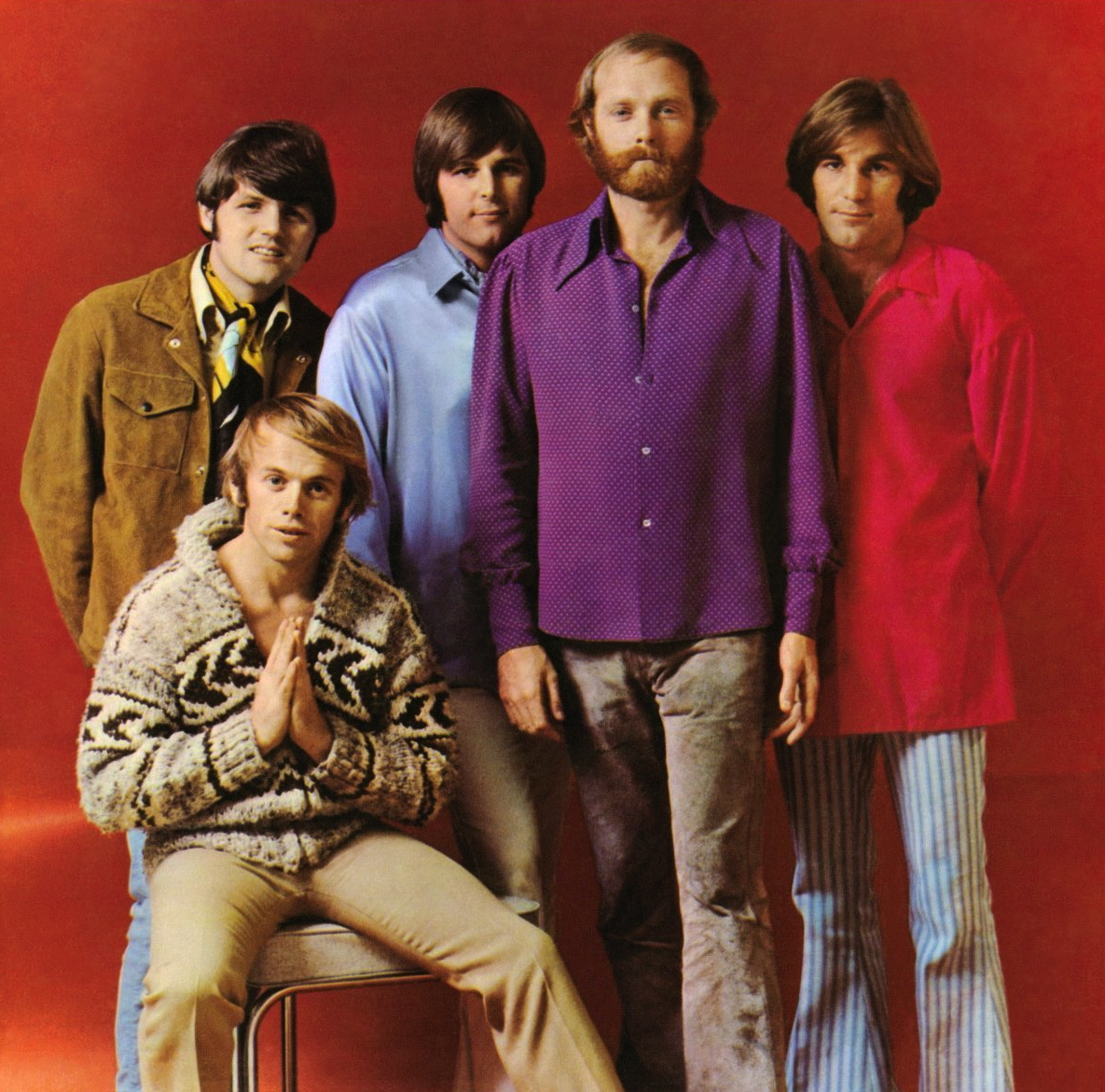
1. Meant For You (alternate version with session intro) (2:17) (B. Wilson-M. Love) Lead vocal: Mike & Brian Recorded April 1, 1968
2. Friends (backing track) (2:38) (B. Wilson-C. Wilson-D.Wilson-Jardine) Recorded March 13, 1968
3. Friends (a Cappella) (2:20) (B. Wilson-C. Wilson-D.Wilson-Jardine) Lead vocal: Carl (with Brian) Recorded March, 1968
4. Wake The World (alternate version) (2:12) (B. Wilson-Jardine) Lead vocal: Group Recorded March 28 & 30, April 1, 1968
5. Be Here In The Morning (backing track) (2:20) (B. Wilson-C. Wilson-D. Wilson-Love-Jardine) Recorded March 29, 1968
6. When A Man Needs A Woman (early take basic track) (0:50) (B. Wilson-D. Wilson-Jardine-Korthof-Parks) Recorded March 18, 1968
7. When A Man Needs A Woman (alternate version) (2:08) (B. Wilson-D. Wilson-Jardine-Korthof-Parks) Lead vocal: Brian Basic track recorded March 18, 1968; vocals recorded March, 1968
8. Passing By (alternate version) (1:44) (B. Wilson) Lead vocal: Brian Recorded March 22, 1968
9. Anna Lee The Healer (session excerpt) (1:22) (B. Wilson-Love) Recorded April 2, 1968
10. Anna Lee The Healer (a Cappella) (1:54) (B. Wilson-Love) Lead Vocal: Group Recorded April 2, 1968
11. Little Bird (backing track) (2:00) (D.Wilson-Kalinich) Recorded February 29, 1968
12. Little Bird (a Cappella) (2:04) (D.Wilson-Kalinich) Lead vocal: Dennis & Carl Vocals recorded February 29 - March, 1968
13. Be Still (alternate take with session excerpt) (2:09) (D.Wilson-Kalinich) Lead vocal: Dennis Recorded April 3,1968
14. Even Steven (early version of “Busy Doin’ Nothin’) (2:52) (B. Wilson) Lead vocal: Brian Recorded March 26, 1968
15. Diamond Head (alternate version with session excerpt) (4:33) (Vescovo-Ritz-Ackley-B. Wilson) Recorded April 12, 1968
16. New Song (Transcendental Meditation) (backing track with partial vocals) (1:51) (B. Wilson)* Recorded March, 1968
17. Transcendental Meditation (backing track with session excerpt) (2:22) (B. Wilson-Love-Jardine) Recorded April 4, 1968
18. Transcendental Meditation (a Cappella) (1:52) (B. Wilson-Love-Jardine) All vocals: Brian Recorded April 4, 1968
19. My Little Red Book (2:45) (Bacharach-David) Lead vocal: Brian Recorded April, 1968
20. Away (track) (0:57) (D. Wilson-Hinsche) Recorded circa January 1968
21. I’m Confessin’ (demo) (2:17) (B. Wilson) Recorded February or March, 1968
22. I’m Confessin’ / You’re As Cool As Can Be 1 (track) (1:38) (B. Wilson) Recorded February or March, 1968
23. You’re As Cool As Can Be 2 (track) (1:14) (B. Wilson) Recorded February or March, 1968
24. Be Here In The Morning Darling (track) (3:29) (B. Wilson) Recorded March 6, 1968
25. Our New Home (track) (2:02) (B. Wilson) Recorded March 20, 1968
26. New Song (track) (1:26) (B. Wilson) Recorded March, 1968
27. Be Still (alternate track) (1:03) (D. Wilson-Kalinich) Recorded March, 1968
28. Rock and Roll Woman (track) (2:19) (Stills) Recorded March, 1968
29. Time To Get Alone (alternate version demo) (2:04) (B. Wilson) Recorded March, 1968
30. Untitled 1/25/68 (track) (1:07) (D. Wilson) Recorded January 25, 1968
31. Passing By (demo with new lyrics c1971) (2:34) (B. Wilson-Shapiro-Almer) Lead vocal: Brian (with Stan Shapiro & Tandyn Almer) Demo recorded circa 1971
32. Child Is Father Of The Man (original 1966 track mix) (3:36) (B. Wilson) Recorded, mixed & edited late 1966
Track listing and credits for the 20/20 release
1. Do It Again (alternate stereo mix) (2:46) (Brian Wilson-Mike Love) Lead vocal: Mike (with Carl) Recorded May 26, June 6 & 12, 1968
2. Do It Again (a Cappella) (2:30) (Brian Wilson-Mike Love) Lead Vocal: Mike (with Carl) Recorded May 26, June 6 & 12, 1968
3. I Can Hear Music (demo) (1:00) (Barry-Greenwich-Spector) Lead vocal: Carl Recorded circa September, 1968
4. I Can Hear Music (track and backing vocals) (2:42) (Barry-Greenwich-Spector) Lead vocal: Carl Recorded October 1, 1968 (track), October, 1968 (vocals)
5. Bluebirds Over The Mountain (alternate mix) (2:56) (Hickey) Lead vocal: Mike Recorded September 29, 1967, October 15, 16, 28 & 29, 1968
6. Be With Me (demo) (2:45) (D. Wilson) Lead vocal: Dennis Recorded August 29, 1968
7. Be With Me (2018 track mix) (3:17) (D. Wilson) Recorded October 2 & 16, 1968
8. All I Want To Do (Dennis Wilson lead vocal take 2) (2:13) (D. Wilson) Lead vocal: Dennis Recorded November 9, 14, 16, 20 & 21, 1968
9. The Nearest Faraway Place (alternate take) (2:13) (Johnston) Recorded June 20, 1968
10. Cotton Fields (track and backing vocals) (2:25) (Ledbetter) Recorded November 18 & 19, 1968
11. I Went To Sleep (a Cappella 2018 mix) (1:35) (B. Wilson-C. Wilson) Lead vocal: Group Recorded June 1968
12. Time To Get Alone (a Cappella) (3:36) (B. Wilson)Lead vocal: Carl (with Brian and Al) Recorded October 2 & 4, 1968
13. Never Learn Not To Love (track and backing vocals) (2:25) (D. Wilson) Recorded September 11, 16, 17 & 18 1968
14. Never Learn Not To Love (a Cappella) (2:23) (D. Wilson) Lead vocal: Dennis Recorded September 17 & 18, 1968
15. Walk On By (2018 mix) (1:55) (Bacharach-David) Lead vocal: Brian Recorded May 29, 1968
16. Rendezvous (Do It Again early version) (2018 mix) (2:36) (Brian Wilson-Mike Love) Lead vocal: Mike (with Brian) Recorded May 26, 1968
17. We’re Together Again (a Cappella) (2:01) (B. Wilson-R. Wilson) Lead vocal: Brian (with Dennis & Carl) Recorded May 22 - 29, 1968
18. I Can Hear Music (alternate lead vocal) (2:11) (Barry-Greenwich-Spector) Lead vocal: Carl Recorded October 1, 1968
19. All I Wanna Do (early version track) (2:24) (Brian Wilson-Mike Love) Recorded May 24 & June 8, 1968
20. Sail Plane Song (2018 mix) (2:19) (B. Wilson-C. Wilson) Lead vocal: Brian recorded June 8, 1968
21. Old Man River (a Capella 2018 mix) (1:18) (Kern-Hammerstein) Lead vocal: Group Recorded June 5, 1968
22. Medley: Old Folks At Home/Old Man River (alternate version) (2:57) (Foster/Kern-Hammerstein) Lead vocal: Group Recorded June 10, 1968
23. Medley: Old Folks At Home/Old Man River (alternate version track) (2:59) (Foster/Kern-Hammerstein) Recorded June 10, 1968
24. Walkin’ (2:48) (B. Wilson-Jardine) Lead vocal: Brian Track recorded June 18 & 19, 1968; vocal recorded circa October, 1969
25. Been Way Too Long (sections) (7:56) (B. Wilson) Lead vocal: Brian (and the group) Recorded Fall 1967, July 24, 25, 26 & 30, 1968
26. Well You Know I Knew (1:42) (D. Wilson) Lead vocal: Dennis Recorded June 3, 1968
27. Love Affair (demo) (2:00) (D. Wilson) Lead vocal: Dennis Recorded August 29, 1968
28. Peaches (demo) (2:26) (D. Wilson) Lead vocal: Dennis Recorded August 29, 1968
29. The Gong (session highlights) (5:29) (D. Wilson) Lead vocal: Dennis Recorded November 16, 1968
30. A Time To Live In Dreams (2018 mix) (1:54) (D. Wilson-Kalinich) Lead vocal: Dennis Recorded November 1, 1968
31. All I Want To Do (early version) (1:12) (D. Wilson) Lead vocal: Dennis Recorded October 16, 1968
32. All I Want To Do (Dennis Wilson lead vocal take 1) (2:10) (D. Wilson) Lead vocal: Dennis Recorded November 9, 14, 16, 20 & 21, 1968
33. Bluebirds Over The Mountain (basic track) (1:48) (Hickey) Recorded September 29, 1967
34. Bluebirds Over The Mountain (mono single mix) (2:51) (Hickey) Lead vocal: Mike Recorded September 29, 1967, October 15, 16, 28 & 29, 1968
35. Mona Kana (demo) (1:16) (D. Wilson-Kalinich) Recorded July 25, 1968
36. Mona Kana (2018 mix) (3:03) (D. Wilson-Kalinich) Recorded November 15, 1968
37. We’re Together Again (remake track with backing vocals) (1:58) (B. Wilson-R. Wilson) Recorded September 3, 6 & 9, 1968
38. Time To Get Alone (remake track) (2:46) (B. Wilson) Recorded November 21, 1968
39. Oh Yeah (0:54) unknown Lead vocal: unknown Recorded October 14, 1968
40. Is It True What They Say About Dixie (Audree Wilson) (1:47) (Caesar-Lerner-Gerald) Lead vocal: Audree Wilson Recorded 1968 Produced by Brian Wilson
THE BEACH BOYS 1968: Brian Wilson, Carl Wilson, Dennis Wilson, Mike Love, Al Jardine & Bruce Johnston
Compilation and New Mixes Produced by Mark Linett & Alan Boyd
Edited, Mixed and Mastered by Mark Linett at Your Place Or Mine
Executive Producers: Matt D’Amico & Peter Fletcher
Art Direction: Susan Lavoie
Original Recordings Produced by The Beach Boys
Engineers: Stephen Desper & Jim Lockert
Brother Records, Inc: Jerry Schilling, President
Session Research: Craig Slowinski
Special Thanks: Howie Edelson; Elliot Kendall; Ross Schwartz; Mark Kaplan; Pacific Title Archives; Al Gomes, Connie Watrous & The Rhode Island BB Posse; Stanley Shapiro; Billy Hinsche; Stephen Kalinich; Brad Rosenberger; Lee Dempsey; Andrew G. Doe; Margaret Gwynne; Betty Collignon Wright; Lori Lightfoot; Steve Latshaw; Panayiotis Bogdanos; Les Chan; Monty & Bailey Linett, David Beard & Endless Summer Quarterly
Art Direction: Susan Lavoie
Original Recordings Produced by The Beach Boys
Engineers: Stephen Desper & Jim Lockert
Brother Records, Inc: Jerry Schilling, President
Session Research: Craig Slowinski
Special Thanks: Howie Edelson; Elliot Kendall; Ross Schwartz; Mark Kaplan; Pacific Title Archives; Al Gomes, Connie Watrous & The Rhode Island BB Posse; Stanley Shapiro; Billy Hinsche; Stephen Kalinich; Brad Rosenberger; Lee Dempsey; Andrew G. Doe; Margaret Gwynne; Betty Collignon Wright; Lori Lightfoot; Steve Latshaw; Panayiotis Bogdanos; Les Chan; Monty & Bailey Linett, David Beard & Endless Summer Quarterly
Details from Andrew G. Doe at http://petsoundsforum.com/thread/2828/2018-copyright-sets-friends-sessions?page=9
And live material still to come...
Friday, 7 December 2018
Wednesday night's set lists at The Habit, York
Ron Elderly: -
Just My Imagination
Always On My Mind
I'll See You In My Dreams
Da Elderly: -
I'm So Tired
Rocky Raccoon
Here Comes The Sun
The Elderly Brothers: -
Sitting In The Park
When A Man Loves A Woman
Country Roads
I Saw Her Standing There
On a very wet day, it was a rather quiet night in The Habit. There were just enough players to get through the evening with 3-song sets. A new (to me) player entertained us with some ribald comic songs: Jake Thackray's Bantam Cock, Richard Digance's Sod's Law and an uncredited I'm A Crap Shag!! Nearly a month of listening to the 50th Anniversary Edition of the Beatles' White Album, I indulged myself with a couple of tracks from LP 1 side 2. The after-show jam was most enjoyable as usual.
Just My Imagination
Always On My Mind
I'll See You In My Dreams
Da Elderly: -
I'm So Tired
Rocky Raccoon
Here Comes The Sun
The Elderly Brothers: -
Sitting In The Park
When A Man Loves A Woman
Country Roads
I Saw Her Standing There
On a very wet day, it was a rather quiet night in The Habit. There were just enough players to get through the evening with 3-song sets. A new (to me) player entertained us with some ribald comic songs: Jake Thackray's Bantam Cock, Richard Digance's Sod's Law and an uncredited I'm A Crap Shag!! Nearly a month of listening to the 50th Anniversary Edition of the Beatles' White Album, I indulged myself with a couple of tracks from LP 1 side 2. The after-show jam was most enjoyable as usual.
Thursday, 6 December 2018
Tuesday, 4 December 2018
Bobby Kennedy for President


Bobby Kennedy for President’: Making a Four-Hour Series on a Celebrity Politician Who Actually Respected Government
Director Dawn Porter talks about the surprising final chapter of her Netflix series and the biggest difference between 2018 and the politics of a half-century ago.
Steve Greene
Inndiewire
28 April 2018
Fitting an entire life into four hours is a tall task for any documentary filmmaker. Doing so for a member of the Kennedy family is even more impossible. Focusing on Robert F. Kennedy, middle brother, reluctant politician, and eventual national candidate meant that director Dawn Porter had a very specific guiding idea for the new Netflix documentary series “Bobby Kennedy for President.”
Using a wealth of archival footage showing Kennedy’s public and private life, Porter wanted to keep a consistent force that bound all of these selected stories from a life that simply had too many to include all of them.
“We very quickly realized there’s so much there that you can’t tell everything. There’s just thousands of Bobby Kennedy stories,” Porter told IndieWire. “So the motivating question I wanted to explore was, ‘How does this show us how Bobby Kennedy evolved? What does this particular story tell us about his priorities, what he was passionate about? And then how does it show growth and change?’ Each story had to serve the purpose of explaining Bobby Kennedy’s growth and evolution as a person and a politician.”
Along with the bevy of stories about the politician came a wide variety of opinions. In Porter’s eyes (and in the eyes of the series itself), the idea that Kennedy changed so much over the course of his political and public life meant that no one person had the perfect idea of who he was.
“The people who describe him as a bare-knuckled, aggressive power seeker, I think they’re wrong. I think that he was aggressive, he was smart, he was confident. He was going to do what needed to be done. And people who see him as saintly figure, they’re also wrong. But I do think he’s certainly more saint than sinner,” Porter said. “What you see, particularly at the end of his all-too-short life, was a person who was very comfortable in his moral convictions and was determined to, as much as possible, have the policies to support and reflect those priorities. I think that’s important. He doggedly worked to bring others around to understand where his opinions came from.”
Of course, it’s impossible to talk about Kennedy without discussing the family that fostered and helped sustain his political career, just as he had done for his brother during the 1960 presidential campaign. Robert Kennedy himself had a large household of his own, to say nothing of the extended Hyannis Port family that features prominently in a few of the home videos on display in “Bobby Kennedy for President.” By design, Porter didn’t interview any of the members of the Kennedy family for her film, but for her that helped her figure out what she wanted “Bobby Kennedy for President” to be.

Dolores Huerta and Dawn Porter
“While he is a public figure to us, he is a father and husband to them. Rory Kennedy made the beautiful film ‘Ethel’ and that was more of the family. It’s a large family, a diverse family. They all have different opinions. Maybe this isn’t something that we needed them for, for better or worse,” Porter said. “Certainly I would have loved to speak to particularly some of the older children and to Ethel Kennedy just about, you know, the history and her experiences. So I leave that to someone else. I think that it’s a rich story that will continue and there’s many possibilities for expanding it. And I hope this whets people’s appetites for more understanding of that era and that time.”
“Bobby Kennedy for President” features few historians in the traditional sense. When assembling the tight group of Kennedy colleagues and confidants to help illuminate the private life behind his public actions, Porter wanted to interview people who could offer direct, unmediated glimpses into their personal relationships with Kennedy. With a figure about whom so many facts are already part of an established record, Porter wanted to find the emotional anchors like Rep. John Lewis, Rep. Neil Gallagher, and former ambassador William vanden Heuvel who could speak to the range of ideals and criticisms that Kennedy inspired in those he met.
“This was a person to them. He wasn’t a statue. He wasn’t a person you read about in a book. I think that it gave a layer to the interviews that I was looking for,” Porter said. “I wanted it to be a smaller group. When you know somebody’s relationship with the main subject, you can understand whatever biases they have. You give the audience a little bit more power to understand that this is where these people are coming from.”
Fitting an entire life into four hours is a tall task for any documentary filmmaker. Doing so for a member of the Kennedy family is even more impossible. Focusing on Robert F. Kennedy, middle brother, reluctant politician, and eventual national candidate meant that director Dawn Porter had a very specific guiding idea for the new Netflix documentary series “Bobby Kennedy for President.”
Using a wealth of archival footage showing Kennedy’s public and private life, Porter wanted to keep a consistent force that bound all of these selected stories from a life that simply had too many to include all of them.
“We very quickly realized there’s so much there that you can’t tell everything. There’s just thousands of Bobby Kennedy stories,” Porter told IndieWire. “So the motivating question I wanted to explore was, ‘How does this show us how Bobby Kennedy evolved? What does this particular story tell us about his priorities, what he was passionate about? And then how does it show growth and change?’ Each story had to serve the purpose of explaining Bobby Kennedy’s growth and evolution as a person and a politician.”
Along with the bevy of stories about the politician came a wide variety of opinions. In Porter’s eyes (and in the eyes of the series itself), the idea that Kennedy changed so much over the course of his political and public life meant that no one person had the perfect idea of who he was.
“The people who describe him as a bare-knuckled, aggressive power seeker, I think they’re wrong. I think that he was aggressive, he was smart, he was confident. He was going to do what needed to be done. And people who see him as saintly figure, they’re also wrong. But I do think he’s certainly more saint than sinner,” Porter said. “What you see, particularly at the end of his all-too-short life, was a person who was very comfortable in his moral convictions and was determined to, as much as possible, have the policies to support and reflect those priorities. I think that’s important. He doggedly worked to bring others around to understand where his opinions came from.”
Of course, it’s impossible to talk about Kennedy without discussing the family that fostered and helped sustain his political career, just as he had done for his brother during the 1960 presidential campaign. Robert Kennedy himself had a large household of his own, to say nothing of the extended Hyannis Port family that features prominently in a few of the home videos on display in “Bobby Kennedy for President.” By design, Porter didn’t interview any of the members of the Kennedy family for her film, but for her that helped her figure out what she wanted “Bobby Kennedy for President” to be.
Dolores Huerta and Dawn Porter
“While he is a public figure to us, he is a father and husband to them. Rory Kennedy made the beautiful film ‘Ethel’ and that was more of the family. It’s a large family, a diverse family. They all have different opinions. Maybe this isn’t something that we needed them for, for better or worse,” Porter said. “Certainly I would have loved to speak to particularly some of the older children and to Ethel Kennedy just about, you know, the history and her experiences. So I leave that to someone else. I think that it’s a rich story that will continue and there’s many possibilities for expanding it. And I hope this whets people’s appetites for more understanding of that era and that time.”
“Bobby Kennedy for President” features few historians in the traditional sense. When assembling the tight group of Kennedy colleagues and confidants to help illuminate the private life behind his public actions, Porter wanted to interview people who could offer direct, unmediated glimpses into their personal relationships with Kennedy. With a figure about whom so many facts are already part of an established record, Porter wanted to find the emotional anchors like Rep. John Lewis, Rep. Neil Gallagher, and former ambassador William vanden Heuvel who could speak to the range of ideals and criticisms that Kennedy inspired in those he met.
“This was a person to them. He wasn’t a statue. He wasn’t a person you read about in a book. I think that it gave a layer to the interviews that I was looking for,” Porter said. “I wanted it to be a smaller group. When you know somebody’s relationship with the main subject, you can understand whatever biases they have. You give the audience a little bit more power to understand that this is where these people are coming from.”
When asked whether Robert Kennedy had any modern analogues, Porter cited some of the spirit that guided President Obama’s second term, particularly the decisions to commute and pardon long-overdue sentences and advances in voter rights. But part of the allure of making this series for Porter was to spend time profiling a figure who to her exemplified a commitment to service that’s largely gone.
“I think it’s been a lot time since we’ve had a politician like Bobby Kennedy who you really unequivocally knew what he stood for. He had a particular position and power and I think he used it wisely,” Porter said. “One of my favorite pieces is when is the students are grilling him about, ‘Why do you want to be a senator?’ And he says, ‘I’d like to serve.’ That was important to his family and that’s how he grew up raising his children. I think that’s admirable.”
Subscribe to:
Comments (Atom)
